A Systematic Review of User Attitudes Toward GenAI: Influencing Factors and Industry Perspectives
Abstract
1. Introduction
1.1. Background
1.1.1. GenAI
1.1.2. Attitude
1.1.3. Creativity and Intelligence
1.2. Research Objectives
2. Materials and Methods
2.1. Literature Retrieval
2.2. Literature Screening
2.3. Data Extraction
3. Results
3.1. Research Methods
3.2. Research Models and Theories
3.3. Meta-Analysis
3.3.1. Dependent Variables
3.3.2. Independent Variables
3.3.3. Meta-Analysis Results
3.3.4. Subgroup Analysis Results
3.4. Application Domain
3.4.1. Education
3.4.2. Creative Industry
3.4.3. Healthcare
3.4.4. Organization
3.5. Bibliometrix Review
3.5.1. Overall Trend of Publications and Citation
3.5.2. Author Collaborative Network Analysis
3.5.3. Analysis of Contribution of Institutions and Countries
3.5.4. Publication Co-Citation Analysis
3.5.5. Hot Spots and Trend Analysis
4. Discussion
4.1. Comprehensive Analysis
4.1.1. Theoretical Model
4.1.2. Variable Analysis
4.1.3. Industry Perspective
4.2. Limitations
4.3. Future Research Directions
5. Conclusions
Supplementary Materials
Author Contributions
Funding
Institutional Review Board Statement
Informed Consent Statement
Acknowledgments
Conflicts of Interest
Appendix A
| Field | Positive Factor | Negative Factor | Regulatory Factor |
|---|---|---|---|
| Travel and Hotel Services (n = 14) | Practicality (T. Kim et al. 2024), perceived trust (R. Law et al. 2024), satisfaction, parasocial interaction (Duong et al. 2024), perceived coolness, perceived enjoyment, perceived usefulness, perceived ease of use (S. Li et al. 2024), anthropomorphism, expectancy, emotion (Rao et al. 2020; H. Lin et al. 2020), communication quality, accuracy, timeliness, understandability, personalization (Y. Li and Lee 2024), emotions, performance expectancy (Vitezić and Perić 2021), advice elaboration (Spatscheck et al. 2024) | Incorrect information (J. H. Kim et al. 2025), effort expectancy (Vitezić and Perić 2021), anthropomorphism (Spatscheck et al. 2024) | Individual innovation (T. Kim et al. 2024), AI hallucination (Christensen et al. 2024), technology anxiety (Duong et al. 2024), ethical and quality concerns (J. H. Kim et al. 2023) |
| Academic research (n = 13) | Time and energy saving, innovative software (Durak and Cankaya 2024), capability to simulate human behavior, enhancement in research techniques (Bail 2024), awareness of GAI advantages (Kshetri 2024), writing motivation, self-efficacy, engagement, collaborative writing tendency (Teng 2024), personal innovativeness (Strzelecki et al. 2024) | Negative effects on reading habits, reduced originality, academic dishonesty, and monotonous writing (Durak and Cankaya 2024) Bias in AI Tools, risk of replication, poor quality studies, misinformation, ethical (Bail 2024), menace to original thinking, new scientific ideas, academic, research integrity (Bannister et al. 2023; Kapsali et al. 2024), | Familiarity and experience with technology, academic background, institutional policies and guidelines, cultural and educational values (Durak and Cankaya 2024), open-source infrastructure, community standards, and guidelines (Bail 2024) |
| Shopping (n = 10) | Perceived interaction quality, perceived trustworthiness, perceptual anthropomorphism (Chakraborty et al. 2024), competence, warmth, empathy (Woo and Hur 2023), utilitarian factors, hedonic factors (Marjerison et al. 2022), enjoyment, subjective norms (Sohn and Kwon 2020) | Perceived inertia, perceived threats, perceived regret avoidance (Chakraborty et al. 2024), privacy concerns, technology immaturity (Marjerison et al. 2022) | Anthropomorphism (Chakraborty et al. 2024), visual, textual closeness GenAI experience level (Martínez Puertas et al. 2024), brand awareness (W. Chang and Park 2024) |
| Software Engineering (n = 2) | Compatibility, social factors. perceptions about the technology (Russo 2024), perceived Intelligence, perceived Anthropomorphism (Diirr et al. 2024) | Interaction Intensity (Diirr et al. 2024) | |
| Catering Service (n = 2) | Perceived risk (K. P. Gupta and Pande 2022) | Gender, familiarity, experience (K. P. Gupta and Pande 2022) |
References
- Abu Hammour, Khawla, Mohammed Zawiah, Lobna Gharaibeh, Rana Abu Farha, Karem H. Alzoubi, Qutaiba A. Qasim, Fahmi Y. Al-Ashwal, and Fahd Abrah. 2023. ChatGPT and Clinical Training: Perception, Concerns, and Practice of Pharm-D Students. Journal of Multidisciplinary Healthcare 16: 4099–110. Available online: https://www.tandfonline.com/doi/full/10.2147/JMDH.S439223 (accessed on 25 August 2024).
- Abu-Farha, Rana, Leen Fino, Fahmi Y. Al-Ashwal, Mohammed Zawiah, Lobna Gharaibeh, Mea’ad M. Harahsheh, and Feras Darwish Elhajji. 2023. ‘Evaluation of Community Pharmacists’ Perceptions and Willingness to Integrate ChatGPT into Their Pharmacy Practice: A Study from Jordan. Journal of the American Pharmacists Association 63: 1761–67.e2. [Google Scholar] [CrossRef]
- Ajze, I. 1991. The Theory of Planned Behavior. Available online: https://www.sciencedirect.com/science/article/abs/pii/074959789190020T (accessed on 27 August 2024).
- Ajzen, Icek. 1985. From Intentions to Actions: A Theory of Planned Behavior. In Action Control: From Cognition to Behavior. Edited by Julius Kuhl and Jürgen Beckmann. Berlin and Heidelberg: Springer, pp. 11–39. [Google Scholar] [CrossRef]
- Alexiou, Andreas, and Derek N. J. Lingmont. 2020. The Contingent Effect of Job Automating Technology Awareness on Perceived Job Insecurity: Exploring the Moderating Role of Organizational Culture. Technological Forecasting and Social Change 161: 120302. [Google Scholar] [CrossRef]
- Almogren, Abeer S., Waleed Mugahed Al-Rahmi, and Nisar Ahmed Dahri. 2024. Exploring Factors Influencing the Acceptance of ChatGPT in Higher Education: A Smart Education Perspective. Heliyon 10: e31887. Available online: https://webofscience.clarivate.cn/wos/alldb/full-record/WOS:001246482300001 (accessed on 24 August 2024). [CrossRef]
- Almufarreh, Ahmad. 2024. Determinants of Students’ Satisfaction with AI Tools in Education: A PLS-SEM-ANN Approach. Sustainability 16: 5354. Available online: https://webofscience.clarivate.cn/wos/alldb/full-record/WOS:001266597300001 (accessed on 25 August 2024). [CrossRef]
- Alsharhan, Abdulla, Mostafa Al-Emran, and Khaled Shaalan. 2023. Chatbot Adoption: A Multiperspective Systematic Review and Future Research Agenda. IEEE Transactions on Engineering Management 71: 10232–44. Available online: https://ieeexplore.ieee.pubapi.xyz/document/10203002 (accessed on 21 August 2024). [CrossRef]
- Al-Qaysi, Noor, Mostafa Al-Emran, Mohammed A. Al-Sharafi, Mohammad Iranmanesh, Azhana Ahmad, and Moamin A. Mahmoud. 2024. Determinants of ChatGPT Use and Its Impact on Learning Performance: An Integrated Model of BRT and TPB. International Journal of Human-Computer Interaction 41: 5462–74. [Google Scholar] [CrossRef]
- Amann, Julia, Effy Vayena, Kelly E. Ormond, Dietmar Frey, Vince I. Madai, and Alessandro Blasimme. 2023. Expectations and Attitudes towards Medical Artificial Intelligence: A Qualitative Study in the Field of Stroke. PLoS ONE 18: e0279088. [Google Scholar] [CrossRef]
- Amaro, Ilaria, Paola Barra, Attilio Della Greca, Rita Francese, and Cesare Tucci. 2024. Believe in Artificial Intelligence? A User Study on the ChatGPT’s Fake Information Impact. IEEE Transactions on Computational Social Systems 11: 5168–77. [Google Scholar] [CrossRef]
- Amoozadeh, Matin, David Daniels, Daye Nam, Aayush Kumar, Stella Chen, Michael Hilton, Sruti Srinivasa Ragavan, and Mohammad Amin Alipour. 2024. Trust in Generative AI among Students. Paper presented at 55th ACM Technical Symposium on Computer Science Education, SIGCSE 2024, Portland, OR, USA, March 20–23; New York: Assoc Computing Machinery, vol. 1, pp. 67–73. [Google Scholar] [CrossRef]
- Anderson, Olivia S., Frederique A. Laubepin, and Ella T. August. 2024. Public Health Students and Instructors Weigh in on Generative Artificial Intelligence: Are They on The Same Page? Pedagogy in Health Promotion 10: 170–77. Available online: https://webofscience.clarivate.cn/wos/alldb/full-record/WOS:001217487000001 (accessed on 25 August 2024). [CrossRef]
- Andrade, Chittaranjan. 2021. A Student’s Guide to the Classification and Operationalization of Variables in the Conceptualization and Design of a Clinical Study: Part 1. Indian Journal of Psychological Medicine 43: 177–79. [Google Scholar] [CrossRef] [PubMed]
- Arias-Pérez, José, and Juan Vélez-Jaramillo. 2022. Ignoring the Three-Way Interaction of Digital Orientation, Not-Invented-Here Syndrome and Employee’s Artificial Intelligence Awareness in Digital Innovation Performance: A Recipe for Failure. Technological Forecasting and Social Change 174: 121305. Available online: https://www.sciencedirect.com/science/article/abs/pii/S0040162521007393?via%3Dihub (accessed on 25 August 2024). [CrossRef]
- Bail, Christopher A. 2024. Can Generative AI Improve Social Science? Proceedings of the National Academy of Sciences USA 121: e2314021121. Available online: https://www.pnas.org/doi/full/10.1073/pnas.2314021121 (accessed on 23 August 2024). [CrossRef] [PubMed]
- Bankins, Sarah, Anna Carmella Ocampo, Mauricio Marrone, Simon Lloyd D. Restubog, and Sang Eun Woo. 2024. A Multilevel Review of Artificial Intelligence in Organizations: Implications for Organizational Behavior Research and Practice. Journal of Organizational Behavior 45: 159–82. [Google Scholar] [CrossRef]
- Bannister, Peter, Alexandra Santamaria-Urbieta, and Elena Alcalde-Penalver. 2023. A Delphi Study on Generative Artificial Intelligence and English Medium Instruction Assessment: Implications for Social Justice. Iranian Journal of Language Teaching Research 11: 53–80. [Google Scholar] [CrossRef]
- Beghetto, Ronald A., and Giovanni Emanuele Corazza. 2019. Dynamic Perspectives on Creativity: New Directions for Theory, Research, and Practice in Education. New York: Springer. Available online: https://www.researchgate.net/publication/330468452_Dynamic_Perspectives_on_Creativity_New_Directions_for_Theory_Research_and_Practice_in_Education (accessed on 4 June 2025).
- Bhaskar, Preeti, Pankaj Misra, and Gaurav Chopra. 2024. Shall I Use ChatGPT? A Study on Perceived Trust and Perceived Risk towards ChatGPT Usage by Teachers at Higher Education Institutions. The International Journal of Information and Learning Technology 41: 428–47. Available online: https://www.emerald.com/insight/content/doi/10.1108/ijilt-11-2023-0220/full/html (accessed on 23 April 2025). [CrossRef]
- Blease, Charlotte, Abigail Worthen, and John Torous. 2024. Psychiatrists’ Experiences and Opinions of Generative Artificial Intelligence in Mental Healthcare: An Online Mixed Methods Survey. Psychiatry Research 333: 115724. [Google Scholar] [CrossRef]
- Borenstein, Michael, Larry V. Hedges, Julian P. T. Higgins, and Hannah R. Rothstein. 2021. Introduction to Meta-Analysis. Hoboken: John Wiley & Sons. [Google Scholar]
- Britannica. 2025. What Is Human Intelligence? Available online: https://www.britannica.com/question/What-is-human-intelligence (accessed on 13 March 2025).
- Bryman, Alan. 2016. Social Research Methods. Oxford: Oxford University Press. Available online: https://books.google.co.jp/books?hl=en&lr=&id=N2zQCgAAQBAJ&oi=fnd&pg=PP1&dq=Social+Research+Methods+(5th+ed.).&ots=dqKvJTM4uj&sig=0_4LPA5DlyjFFBBmbewkt2a0PuA&redir_esc=y#v=onepage&q=Social%20Research%20Methods%20(5th%20ed.).&f=false (accessed on 27 August 2024).
- Chakraborty, Debarun, Arpan Kumar Kar, Smruti Patre, and Shivam Gupta. 2024. Enhancing Trust in Online Grocery Shopping through Generative AI Chatbots. Journal of Business Research 180: 114737. [Google Scholar] [CrossRef]
- Chan, Cecilia Ka Yuk, and Wenxin Zhou. 2023. An Expectancy Value Theory (EVT) Based Instrument for Measuring Student Perceptions of Generative AI. Smart Learning Environments 10: 64. [Google Scholar] [CrossRef]
- Chang, Woondeog, and Jungkun Park. 2024. A Comparative Study on the Effect of ChatGPT Recommendation and AI Recommender Systems on the Formation of a Consideration Set. Journal of Retailing and Consumer Services 78: 103743. Available online: https://www.sciencedirect.com/science/article/abs/pii/S0969698924000390 (accessed on 30 August 2024). [CrossRef]
- Chang, Younghoon, Seongyong Lee, Siew Fan Wong, and Seon-phil Jeong. 2022. AI-Powered Learning Application Use and Gratification: An Integrative Model. Information Technology & People 35: 2115–39. [Google Scholar] [CrossRef]
- Chi, Oscar Hengxuan, Christina G. Chi, Dogan Gursoy, and Robin Nunkoo. 2023. Customers’ acceptance of artificially intelligent service robots: The influence of trust and culture. International Journal of Information Management 70: 102623. [Google Scholar] [CrossRef]
- Christensen, Jeff, Jared M. Hansen, and Paul Wilson. 2024. Understanding the Role and Impact of Generative Artificial Intelligence (AI) Hallucination within Consumers’ Tourism Decision-Making Processes. Current Issues in Tourism 28: 545–60. [Google Scholar] [CrossRef]
- Cimino, Antonio, Alberto Michele Felicetti, Vincenzo Corvello, Valentina Ndou, and Francesco Longo. 2024. Generative artificial intelligence (AI) tools in innovation management: A study on the appropriation of ChatGPT by innovation managers. Management Decision. ahead-of-print. [Google Scholar]
- Cohen, Jacob. 2013. Statistical Power Analysis for the Behavioral Sciences, 2nd ed. New York: Routledge. [Google Scholar] [CrossRef]
- Corazza, Giovanni Emanuele. 2016. Potential Originality and Effectiveness: The Dynamic Definition of Creativity. Creativity Research Journal 28: 258–67. [Google Scholar] [CrossRef]
- Creely, Edwin, and Jo Blannin. 2025. Creative Partnerships with Generative AI. Possibilities for Education and Beyond. Thinking Skills and Creativity 56: 101727. [Google Scholar] [CrossRef]
- Csikszentmihalyi, Mihaly. 1998. Implications of a Systems Perspective for the Study of Creativity. In Handbook of Creativity. Cambridge: Cambridge University Press, pp. 313–36. [Google Scholar] [CrossRef]
- Dahri, Nisar Ahmed, Noraffandy Yahaya, Waleed Mugahed Al-Rahmi, Ahmed Aldraiweesh, Uthman Alturki, Sultan Almutairy, Anna Shutaleva, and Rahim Bux Soomro. 2024. Extended TAM Based Acceptance of AI-Powered ChatGPT for Supporting Metacognitive Self-Regulated Learning in Education: A Mixed-Methods Study. Heliyon 10: e29317. Available online: https://webofscience.clarivate.cn/wos/alldb/full-record/WOS:001226756000001 (accessed on 25 August 2024). [CrossRef] [PubMed]
- Davis, Fred D. 1989. Perceived Usefulness, Perceived Ease of Use, and User Acceptance of Information Technology. MIS Quarterly, 319–40. Available online: https://www.jstor.org/stable/249008 (accessed on 22 August 2024). [CrossRef]
- De Vreede, Triparna, Vivek Kumar Singh, Gert-Jan De Vreede, and Paul Spector. 2024. The Effect of IS Engagement on Generative AI Adoption. Paper presented at 57th Hawaii International Conference on System Sciences, Hawaiian Village, HI, USA, January 3–6; Available online: https://hdl.handle.net/10125/106396 (accessed on 8 June 2025).
- Diirr, Bruna, Adriana C. F. Alvim, Rodrigo Pereira Dos Santos, Patricia de Oliveira Santos, Allan Chamon Figueiredo, and Pedro Nuno Moura. 2024. How Do Information Technology Professionals Use Generative Artificial Intelligence? Paper Presented at the 20th Brazilian Symposium on Information Systems, Juiz de Fora, Brazil, May 20–23. Available online: https://dl.acm.org/doi/10.1145/3658321.3658367 (accessed on 26 August 2024).
- Dinev, Tamara, and Paul Hart. 2006. An Extended Privacy Calculus Model for E-Commerce Transactions. Information Systems Research 17: 61–80. [Google Scholar] [CrossRef]
- Ding, Li. 2021. Employees’ Challenge-Hindrance Appraisals toward STARA Awareness and Competitive Productivity: A Micro-Level Case. International Journal of Contemporary Hospitality Management 33: 2950–69. Available online: https://www.emerald.com/insight/content/doi/10.1108/IJCHM-09-2020-1038/full/html (accessed on 25 August 2024). [CrossRef]
- Doshi, Anil R., and Oliver P. Hauser. 2024. Generative AI Enhances Individual Creativity but Reduces the Collective Diversity of Novel Content. Science Advances 10: eadn5290. [Google Scholar] [CrossRef] [PubMed]
- Douglass, Rodney B. 1977. Review of Review of Belief, Attitude, Intention, and Behavior: An Introduction to Theory and Research, by Martin Fishbein and Icek Ajzen. Philosophy & Rhetoric 10: 130–32. [Google Scholar]
- Du, Lei, and Beibei Lv. 2024. Factors Influencing Students’ Acceptance and Use Generative Artificial Intelligence in Elementary Education: An Expansion of the UTAUT Model. Education and Information Technologies 29: 24715–34. [Google Scholar] [CrossRef]
- Duffourc, Mindy, and Sara Gerke. 2023. Generative AI in Health Care and Liability Risks for Physicians and Safety Concerns for Patients. JAMA 330: 313–14. [Google Scholar] [CrossRef] [PubMed]
- Duong, Cong Doanh, Thanh Hieu Nguyen, Thi Viet Nga Ngo, Van Thanh Dao, Ngoc Diep Do, and Thanh Van Pham. 2024. Exploring higher education students’ continuance usage intention of ChatGPT: Amalgamation of the information system success model and the stimulus-organism-response paradigm. International Journal of Information and Learning Technology 41: 556–84. [Google Scholar] [CrossRef]
- Duong, Cong Doanh, Trong Nghia Vu, and Thi Viet Nga Ngo. 2023. Applying a Modified Technology Acceptance Model to Explain Higher Education Students’ Usage of ChatGPT: A Serial Multiple Mediation Model with Knowledge Sharing as a Moderator. International Journal of Management Education 21: 100883. [Google Scholar] [CrossRef]
- Durak, Gurhan, and Serkan Cankaya. 2024. Are alarm bells ringing in academia? Chatgpt as a sample of using chatbots in education. Turkish Online Journal of Distance Education 25: 1–17. [Google Scholar] [CrossRef]
- Dwivedi, Yogesh K., Nir Kshetri, Laurie Hughes, Emma Louise Slade, Anand Jeyaraj, Arpan Kumar Kar, Abdullah M. Baabdullah, Alex Koohang, Vishnupriya Raghavan, Manju Ahuja, and et al. 2023. Opinion Paper: ‘So What If ChatGPT Wrote It?’ Multidisciplinary Perspectives on Opportunities, Challenges and Implications of Generative Conversational AI for Research, Practice and Policy. International Journal of Information Management 71: 102642. [Google Scholar] [CrossRef]
- Dwivedi, Yogesh K., Nripendra P. Rana, Anand Jeyaraj, Marc Clement, and Michael D. Williams. 2019. Re-Examining the Unified Theory of Acceptance and Use of Technology (UTAUT): Towards a Revised Theoretical Model. Information Systems Frontiers 21: 719–34. [Google Scholar] [CrossRef]
- Facione, Peter. 1989. Critical Thinking: A Statement of Expert Consensus for Purposes of Educational Assessment and Instruction. Available online: https://www.researchgate.net/publication/242279575_Critical_Thinking_A_Statement_of_Expert_Consensus_for_Purposes_of_Educational_Assessment_and_Instruction (accessed on 23 April 2025).
- Featherman, Mauricio S., and Paul A. Pavlou. 2003. Predicting E-Services Adoption: A Perceived Risk Facets Perspective. 2003. International Journal of Human-Computer Studies 59: 451–74. [Google Scholar] [CrossRef]
- Figueiredo, Ronnie, Maria Emilia Camargo, João J. Ferreira, Justin Zuopeng Zhang, and Yulong David Liu. 2022. Predicting the Intention to Adopt Innovation in Supply Chain Finance. Journal of Organizational and End User Computing 35: 1–27. [Google Scholar] [CrossRef]
- Franceschelli, Giorgio, and Mirco Musolesi. 2024. Creativity and Machine Learning: A Survey. ACM Computing Surveys 56: 283:1–283:41. [Google Scholar] [CrossRef]
- Fu, Chung-Jen, Andri Dayarana K. Silalahi, Shu-Chin Huang, Do Thi Thanh Phuong, Ixora Javanisa Eunike, and Zhou-Houg Yu. 2024. The (Un)Knowledgeable, the (Un)Skilled? Undertaking Chat-GPT Users’ Benefit-Risk-Coping Paradox in Higher Education Focusing on an Integrated, UTAUT and PMT. International Journal of Human–Computer Interaction 41: 5663–93. [Google Scholar] [CrossRef]
- Füller, Johann, Anja Eisenreich, Julian Just, and Daniela Gimenez-Jimenez. 2024. Revolution or Inflated Expectations? Exploring the Impact of Generative AI on Ideation in a Practical Sustainability Context. 2024. Technovation 138: 103123. [Google Scholar] [CrossRef]
- Gao, Ziyi, Jun-Hwa Cheah, Xin-Jean Lim, and Xi Luo. 2024. Enhancing Academic Performance of Business Students Using Generative AI: An Interactive-Constructive-Active-Passive (ICAP) Self-Determination Perspective. International Journal of Management Education 22: 100958. [Google Scholar] [CrossRef]
- Gefen, David, Elena Karahanna, and Detmar W. Straub. 2003. Trust and TAM in Online Shopping: An Integrated Model. MIS Quarterly 27: 51–90. Available online: https://www.researchgate.net/publication/220260204_Trust_and_TAM_in_Online_Shopping_An_Integrated_Model (accessed on 23 April 2025). [CrossRef]
- Glăveanu, Vlad Petre. 2014. The Psychology of Creativity: A Critical Reading. Creativity Theories Research Applications 1: 10–32. [Google Scholar] [CrossRef]
- Golin, Marta, and Stefania Innocenti. 2022. Human Capital Investment and Perceived Automation Risks: Evidence from 16 Countries. 2022. Journal of Economic Behavior & Organization 195: 27–41. [Google Scholar] [CrossRef]
- Gopinath, Krishnan, and Dharun Kasilingam. 2023. Antecedents of Intention to Use Chatbots in Service Encounters: A Meta-analytic Review. International Journal of Consumer Studies 47: 2367–95. [Google Scholar] [CrossRef]
- Gravina, Antonietta Gerarda, Raffaele Pellegrino, Marina Cipullo, Giovanna Palladino, Giuseppe Imperio, Andrea Ventura, Salvatore Auletta, Paola Ciamarra, and Alessandro Federico. 2024. May ChatGPT Be a Tool Producing Medical Information for Common Inflammatory Bowel Disease Patients’ Questions? An Evidence-Controlled Analysis. World Journal of Gastroenterology 30: 17–33. [Google Scholar] [CrossRef]
- Gu, Li, and Yong Li. 2022. Who Made the Paintings: Artists or Artificial Intelligence? The Effects of Identity on Liking and Purchase Intention. Frontiers in Psychology 13: 941163. [Google Scholar] [CrossRef]
- Gu, Chenyan, Shuyue Jia, Jiaying Lai, Ruli Chen, and Xinsiyu Chang. 2024. Exploring Consumer Acceptance of AI-Generated Advertisements: From the Perspectives of Perceived Eeriness and Perceived Intelligence. Journal of Theoretical and Applied Electronic Commerce Research 19: 2218–38. [Google Scholar] [CrossRef]
- Gupta, Kriti Priya, and Smriti Pande. 2022. Indian Customers’ Acceptance of Service Robots in Restaurant Services. Behaviour & Information Technology 42: 1946–67. Available online: https://www.tandfonline.com/doi/abs/10.1080/0144929X.2022.2103734 (accessed on 30 August 2024).
- Gupta, Maanak, Charankumar Akiri, Kshitiz Aryal, Eli Parker, and Lopamudra Praharaj. 2023. From ChatGPT to ThreatGPT: Impact of Generative AI in Cybersecurity and Privacy. IEEE Access 11: 80218–45. [Google Scholar] [CrossRef]
- Gupta, Varun. 2024. An Empirical Evaluation of a Generative Artificial Intelligence Technology Adoption Model from Entrepreneurs’ Perspectives. Systems 12: 103. [Google Scholar] [CrossRef]
- Gursoy, Dogan, Oscar Hengxuan Chi, Lu Lu, and Robin Nunkoo. 2019. Consumers Acceptance of Artificially Intelligent (AI) Device Use in Service Delivery. International Journal of Information Management 49: 157–69. [Google Scholar] [CrossRef]
- Haber, Yuval, Inbar Levkovich, Dorit Hadar-Shoval, and Zohar Elyoseph. 2024. The Artificial Third: A Broad View of the Effects of Introducing Generative Artificial Intelligence on Psychotherapy. JMIR Mental Health 11: e54781. [Google Scholar] [CrossRef]
- Heckman, James J., and Richard Robb. 1985. Alternative Methods for Evaluating the Impact of Interventions: An Overview. Journal of Econometrics 30: 239–67. Available online: https://www.sciencedirect.com/science/article/abs/pii/0304407685901393 (accessed on 27 August 2024). [CrossRef]
- Herani, Rina, and Jovita Angela. 2024. Navigating ChatGPT: Catalyst or Challenge for Indonesian Youth in Digital Entrepreneurship? Journal of Entrepreneurship in Emerging Economies 17: 602–28. [Google Scholar] [CrossRef]
- Hernandez, Alexander A., Mideth B. Abisado, Ramon L. Rodriguez, and Joseph Marvin R. Imperial. 2023. Predicting the Use Behavior of Higher Education Students on ChatGPT: Evidence from the Philippines. Paper presented at 2023 IEEE International Conference on Teaching, Assessment and Learning for Engineering (TALE), Auckland, New Zealand, November 28–December 1; New York: IEEE. [Google Scholar]
- Hidayat-ur-Rehman, Imdadullah, and Yasser Ibrahim. 2023. Exploring Factors Influencing Educators’ Adoption of ChatGPT: A Mixed Method Approach. Interactive Technology and Smart Education 21: 499–534. [Google Scholar] [CrossRef]
- Higgins, Christopher A., and Deborah R. Compeau. 1995. Computer Self-Efficacy: Development of a Measure and Initial Test. MIS Quarterly 19: 189–211. Available online: https://dl.acm.org/doi/10.2307/249688 (accessed on 24 September 2024).
- Hou, Ting, Meng Li, Yinliang Tan, and Huazhong Zhao. 2024. Physician adoption of AI assistant. Manufacturing & Service Operations Management 26: 1639–55. [Google Scholar] [CrossRef]
- Huynh, Minh-Tay. 2024. Using generative AI as decision-support tools: Unraveling users’ trust and AI appreciation. Journal of Decision Systems, 1–31. [Google Scholar] [CrossRef]
- IBM. 2024. What Are Foundation Models in Generative AI? Available online: https://www.ibm.com/think/insights/generative-ai-benefits (accessed on 21 August 2024).
- Ibrahim, Samar, Ghazala Bilquise, and Sa’eD M. Salhieh. 2023. Investigating Student Acceptance of an Academic Advising Chatbot in Higher Education Institutions. Education and Information Technologies 29: 6357–82. Available online: https://link.springer.com/article/10.1007/s10639-023-12076-x (accessed on 24 August 2024).
- Jadil, Yassine, Nripendra P. Rana, and Yogesh K. Dwivedi. 2021. A Meta-Analysis of the UTAUT Model in the Mobile Banking Literature: The Moderating Role of Sample Size and Culture. Journal of Business Research 132: 354–72. [Google Scholar] [CrossRef]
- Jose, Emily Maria K, Akshara Prasanna, Bijay Prasad Kushwaha, and Madhumita Das. 2024. Can Generative AI Motivate Management Students? The Role of Perceived Value and Information Literacy. The International Journal of Management Education 22: 101082. [Google Scholar] [CrossRef]
- Kamoun, Faouzi, Walid El Ayeb, Ibtissem Jabri, Sami Sifi, and Farkhund Iqbal. 2024. Research—Exploring Students’ and Faculty’s Knowledge, Attitudes, and Perceptions Towards ChatGPT: A Cross-Sectional Empirical Study. Journal of Information Technology Education: Research 23: 1. Available online: https://www.informingscience.org/Publications/5239?Type= (accessed on 25 August 2024).
- Kapsali, Marina Z., Efstratios Livanis, Christos Tsalikidis, Panagoula Oikonomou, Polychronis Voultsos, and Aleka Tsaroucha. 2024. Ethical Concerns About ChatGPT in Healthcare: A Useful Tool or the Tombstone of Original and Reflective Thinking? Cureus Journal of Medical Science 16: e54759. [Google Scholar] [CrossRef]
- Kaufman, James C., and Ronald A. Beghetto. 2009. Beyond Big and Little: The Four C Model of Creativity. Review of General Psychology 13: 1–12. [Google Scholar] [CrossRef]
- Kelly, Sage, Sherrie-Anne Kaye, and Oscar Oviedo-Trespalacios. 2022. A Multi-Industry Analysis of the Future Use of AI Chatbots. Human Behavior and Emerging Technologies 2022: 2552099. [Google Scholar] [CrossRef]
- Kelly, Sage, Sherrie-Anne Kaye, and Oscar Oviedo-Trespalacios. 2023. What Factors Contribute to the Acceptance of Artificial Intelligence? A Systematic Review. Telematics and Informatics 77: 101925. [Google Scholar] [CrossRef]
- Kim, Hye-Young, and Garim Lee. 2023. Human vs. AI: The Battle for Authenticity in Fashion Design and Consumer Response. 2024. Journal of Retailing and Consumer Services 77: 103690. [Google Scholar] [CrossRef]
- Kim, Jeong Hyun, Jungkeun Kim, Changju Kim, and Seongseop Kim. 2023. Do You Trust ChatGPTs? Effects of the Ethical and Quality Issues of Generative AI on Travel Decisions. Journal of Travel & Tourism Marketing 40: 779–801. [Google Scholar] [CrossRef]
- Kim, Jeong Hyun, Jungkeun Kim, Jooyoung Park, Changju Kim, Jihoon Jhang, and Brian King. 2025. When ChatGPT Gives Incorrect Answers: The Impact of Inaccurate Information by Generative AI on Tourism Decision-Making. Journal of Travel Research 64: 51–73. Available online: https://journals.sagepub.com/eprint/9FZY8BQKVRVYPMN8N5VK/full (accessed on 26 August 2024). [CrossRef]
- Kim, Minjin, and Byenghee Chang. 2020. The Effect of Service Quality on the Reuse Intention of a Chatbot: Focusing on User Satisfaction, Reliability, and Immersion. International Journal of Contents 16: 1–15. Available online: https://koreascience.kr/article/JAKO202006763002633.page (accessed on 22 August 2024).
- Kim, Sung S., James Agarwal, and James Agarwal. 2004. Internet Users’ Information Privacy Concerns (IUIPC): The Construct, the Scale, and a Causal Model. Information Systems Research 15: 336–55. Available online: https://www.x-mol.com/paper/1356890486672310272?adv (accessed on 24 September 2024).
- Kim, Taekyung, Myung Ja Kim, and Pornpisanu Promsivapallop. 2024. Investigating the Influence of Generative AI’s Credibility and Utility on Travel Consumer Behaviour and Recommendations through the Lens of Personal Innovativeness. Current Issues in Tourism, 1–5. [Google Scholar] [CrossRef]
- Koivisto, Mika, and Simone Grassini. 2023. Best Humans Still Outperform Artificial Intelligence in a Creative Divergent Thinking Task. Scientific Reports 13: 1–10. [Google Scholar] [CrossRef]
- Kokkoris, Michail D., Florian Buehler, Kobe Millet, and Guanzhong Du. 2023. Defending Humankind: Anthropocentric Bias in the Appreciation of AI Art. 2023. Computers in Human Behavior 143: 107707. [Google Scholar] [CrossRef]
- Koo, Bonhak, Catherine Curtis, and Bill Ryan. 2021. Examining the Impact of Artificial Intelligence on Hotel Employees through Job Insecurity Perspectives. International Journal of Hospitality Management 95: 102763. [Google Scholar] [CrossRef]
- Kshetri, Nir. 2024. The Academic Industry’s Response to Generative Artificial Intelligence: An Institutional Analysis of Large Language Models. Telecommunications Policy 48: 102760. [Google Scholar] [CrossRef]
- Latikka, Rita, Jenna Bergdahl, Nina Savela, and Atte Oksanen. 2023. AI as an Artist? A Two-Wave Survey Study on Attitudes Toward Using Artificial Intelligence in Art. Poetics 101: 101839. [Google Scholar] [CrossRef]
- Law, Locky. 2024. Application of Generative Artificial Intelligence (GenAI) in Language Teaching and Learning: A Scoping Literature Review-All Databases. Computers and Education Open 2024: 100174. Available online: https://webofscience.clarivate.cn/wos/alldb/full-record/WOS:001222577400001 (accessed on 25 August 2024). [CrossRef]
- Law, Rob, Jian Ming Luo, Jon Lovett, Han Xu, and Lu Liu. 2024. Tourist Acceptance of ChatGPT in Travel Services: The Mediating Role of Parasocial Interaction. Journal of Travel & Tourism Marketing 41: 955–972. Available online: https://www.tandfonline.com/doi/full/10.1080/10548408.2024.2364336 (accessed on 26 August 2024).
- Li, Guofa, Da Tao, Yanxuan Zhang, Tingru Zhang, Weisheng Zeng, and Xingda Qu. 2021. What Drives People to Use Automated Vehicles? A Meta-Analytic Review. Accident Analysis & Prevention 159: 106270. [Google Scholar] [CrossRef]
- Li, Jie, Hancheng Cao, Laura Lin, Youyang Hou, Ruihao Zhu, and Abdallah El Ali. 2024. User Experience Design Professionals’ Perceptions of Generative Artificial Intelligence. Paper presented at the CHI ’24: 2024 CHI Conference on Human Factors in Computing Systems, Honolulu, HI, USA, May 11–16. [Google Scholar]
- Li, Lily D., Santoso Wibowo, and Chunpeng Zhai. 2024. The Effects of Over-Reliance on AI Dialogue Systems on Students’ Cognitive Abilities: A Systematic Review. Smart Learning Environments 11: 1–37. Available online: https://link.springer.com/article/10.1186/s40561-024-00316-7 (accessed on 25 August 2024).
- Li, Shuhao, Rui Han, Tianyu Fu, Mimi Chen, and Yuhang Zhang. 2024. Tourists’ Behavioural Intentions to Use ChatGPT for Tour Route Planning: An Extended TAM Model Including Rational and Emotional Factors. Current Issues in Tourism 1–17. Available online: https://www.tandfonline.com/doi/abs/10.1080/13683500.2024.2355563 (accessed on 15 May 2024).
- Li, Tianyu, Chang Gao, and Ying Du. 2023. Why Do Designers in Various Fields Have Different Attitude and Behavioral Intention towards AI Painting Tools? An Extended UTAUT Model. Procedia Computer Science 221: 1519–26. [Google Scholar] [CrossRef]
- Li, Weiyi. 2024. Full Article: A Study on Factors Influencing Designers’ Behavioral Intention in Using AI-Generated Content for Assisted Design: Perceived Anxiety, Perceived Risk, and UTAUT. International Journal of Human–Computer Interaction 41: 1064–77. Available online: https://www.tandfonline.com/doi/full/10.1080/10447318.2024.2310354 (accessed on 24 August 2024). [CrossRef]
- Li, Yu, and Soyeun Olivia Lee. 2024. Navigating the Generative AI Travel Landscape: The Influence of ChatGPT on the Evolution from New Users to Loyal Adopters. International Journal of Contemporary Hospitality Management 37: 1421–47. [Google Scholar] [CrossRef]
- Liberati, Alessandro, Douglas G. Altman, Jennifer Tetzlaff, Cynthia Mulrow, Peter C. Gøtzsche, John P. A. Ioannidis, Mike Clarke, P. J. Devereaux, Jos Kleijnen, and David Moher. 2009. The PRISMA Statement for Reporting Systematic Reviews and Meta-Analyses of Studies That Evaluate Health Care Interventions: Explanation and Elaboration. Journal of Clinical Epidemiology 62: e1–e34. [Google Scholar] [CrossRef]
- Lin, Hongxia, Oscar Hengxuan Chi, and Dogan Gursoy. 2020. Antecedents of Customers’ Acceptance of Artificially Intelligent Robotic Device Use in Hospitality Services. Journal of Hospitality Marketing & Management 29: 530–49. Available online: https://www.tandfonline.com/doi/full/10.1080/19368623.2020.1685053 (accessed on 26 August 2024).
- Lin, Xiaohong, Jun Zhang, Xiaoming Cao, and Beina Zhao. 2024. A Study on Behavioral Intentions of Artificial Intelligence Learning Platform: Comparing the Perspectives of Teachers and Students. Interactive Learning Environments 33: 223–43. [Google Scholar] [CrossRef]
- Littlejohn, Stephen W., and Karen A. Foss. 2010. Theories of Human Communication, 10th ed. Long Grove: Waveland Press. [Google Scholar]
- Liu, Guangxiang Leon, Ron Darvin, and Chaojun Ma. 2024. Unpacking the Role of Motivation and Enjoyment in AI-Mediated Informal Digital Learning of English (AI-IDLE): A Mixed-Method Investigation in the Chinese Context. Computers in Human Behavior 160: 108362. [Google Scholar] [CrossRef]
- Lyu, Yanru, Xinxin Wang, Rungtai Lin, and Jun Wu. 2022. Communication in Human–AI Co-Creation: Perceptual Analysis of Paintings Generated by Text-to-Image System. Applied Sciences 12: 11312. [Google Scholar] [CrossRef]
- Ma, Hui, and Nana Li. 2024. Exploring User Behavioral Intentions and Their Relationship with AI Design Tools: A Future Outlook on Intelligent Design. IEEE Access 12: 149192–205. Available online: https://ieeexplore.ieee.org/abstract/document/10632118 (accessed on 12 May 2025). [CrossRef]
- Ma, Xiaoyue, and Yudi Huo. 2023. Are Users Willing to Embrace ChatGPT? Exploring the Factors on the Acceptance of Chatbots from the Perspective of AIDUA Framework. Technology in Society 75: 102362. [Google Scholar] [CrossRef]
- Magni, Federico, Jiyoung Park, and Melody Manchi Chao. 2024. Humans as Creativity Gatekeepers: Are We Biased Against AI Creativity? Journal of Business and Psychology 39: 643–56. [Google Scholar] [CrossRef]
- Maican, Catalin Ioan, Silvia Sumedrea, Alina Tecau, Eliza Nichifor, Ioana Bianca Chitu, Radu Lixandroiu, and Gabriel Bratucu. 2023. Factors influencing the behavioural intention to use AI-Generated images in business: A UTAUT2 perspective with moderators. Journal of Organizational and End User Computing (JOEUC) 35: 1–32. [Google Scholar] [CrossRef]
- Majid, Gilang Maulana, Iis Tussyadiah, and Yoo Ri Kim. 2024. Exploring the Potential of Chatbots in Extending Tourists’ Sustainable Travel Practices. Journal of Travel Research 64: 1292–317. [Google Scholar] [CrossRef]
- Maphoto, Kgabo, Kershnee Sevnarayan, Ntshimane Mohale, Zuleika Suliman, Tumelo Ntsopi, and Douglas Mokoena. 2024. Advancing Students’ Academic Excellence in Distance Education: Exploring the Potential of Generative AI Integration to Improve Academic Writing Skills. Open Praxis 16: 142–59. [Google Scholar] [CrossRef]
- Marimon, Frederic, Marta Mas-Machuca, and Anna Akhmedova. 2024. Trusting in generative AI: Catalyst for employee performance and engagement in the workplace. International Journal of Human–Computer Interaction 41: 7076–91. [Google Scholar] [CrossRef]
- Marjerison, Rob Kim, Youran Zhang, and Hanyi Zheng. 2022. AI in E-Commerce: Application of the Use and Gratification Model to The Acceptance of Chatbots. Sustainability 14: 14270. [Google Scholar] [CrossRef]
- Martínez Puertas, Sergio, María Dolores Illescas Manzano, Cristina Segovia López, and Paulo Ribeiro Cardoso. 2024. Purchase Intentions in a Chatbot Environment: An Examination of the Effects of Customer Experience. Oeconomia Copernicana 15: 145–94. [Google Scholar] [CrossRef]
- McKinsey. 2024. What Is ChatGPT, DALL-E, and Generative AI? Available online: https://www.mckinsey.com/featured-insights/mckinsey-explainers/what-is-generative-ai (accessed on 11 August 2024).
- Meta-Analysis Package for R. n.d. Available online: https://wviechtb.github.io/metafor/ (accessed on 12 May 2025).
- Micalizzi, Alessandra. 2024. Artificial Creativity. Perceptions and Prejudices on AI Music Production. Paper presented at the Ninth International Congress on Information and Communication Technology, London, UK, February 19–22. [Google Scholar]
- Moon, Ji-Won, and Young-Gul Kim. 2001. Extending the TAM for a World-Wide-Web Context. 2001. Information & Management 38: 217–30. [Google Scholar] [CrossRef]
- Morgan, Robert M., and Shelby D. Hunt. 1994. The Commitment-Trust Theory of Relationship Marketing. Journal of Marketing 58: 20–38. Available online: https://journals.sagepub.com/doi/10.1177/002224299405800302 (accessed on 4 May 2025). [CrossRef]
- Nawaz, Samsudeen Sabraz, Mohamed Buhary Fathima Sanjeetha, Ghadah Al Murshidi, Mohamed Ismail Mohamed Riyath, Fadhilah Bt Mat Yamin, and Rusith Mohamed. 2024. Acceptance of ChatGPT by Undergraduates in Sri Lanka: A Hybrid Approach of SEM-ANN. Interactive Technology and Smart Education 21: 546–70. [Google Scholar] [CrossRef]
- Newman, Michele, Kaiwen Sun, Ilena B Dalla Gasperina, Grace Y. Shin, Matthew Kyle Pedraja, Ritesh Kanchi, Maia B. Song, Rannie Li, Jin Ha Lee, and Jason Yip. 2024. ‘I Want It to Talk like Darth Vader’: Helping Children Construct Creative Self-Efficacy with Generative AI. In Proceedings of the 2024 CHI Conference on Human Factors in Computing Systems. CHI’24. New York: Association for Computing Machinery, pp. 1–18. [Google Scholar] [CrossRef]
- Niu, Wanshu, Wuke Zhang, Chuanxia Zhang, and Xiaofeng Chen. 2024. The Role of Artificial Intelligence Autonomy in Higher Education: A Uses and Gratification Perspective. Sustainability 16: 1276. [Google Scholar] [CrossRef]
- Nov, Oded, Nina Singh, and Devin Mann. 2023. Putting ChatGPT’s Medical Advice to the (Turing) Test: Survey Study. JMIR Medical Education 9: e46939. [Google Scholar] [CrossRef]
- Novozhilova, Ekaterina, Kate Mays, Sejin Paik, and James E. Katz. 2024. More Capable, Less Benevolent: Trust Perceptions of AI Systems across Societal Contexts. Machine Learning and Knowledge Extraction 6: 342–66. [Google Scholar] [CrossRef]
- Nuanchaona, Supakchaya, Supaprawat Siripipatthanakul, Wasutida Nurittamont, and Bordin Phayaphrom. 2021. Factors affecting consumer’s purchase intention of chatbot commerce in Thailand no. 14. IJBMC: An International Journal 1: 1–13. [Google Scholar]
- Oliver, Richard L. 1977. Effect of Expectation and Disconfirmation on Postexposure Product Evaluations: An Alternative Interpretation. Journal of Applied Psychology 62: 480–86. [Google Scholar] [CrossRef]
- Ozmen, Berk B., and Graham S. Schwarz. 2024. Letter to the Editor: The Promise and Pitfalls of AI-Generated Anatomical Images-Evaluating Midjourney for Aesthetic Surgery Applications. Aesthetic Plastic Surgery 49: 2130–31. [Google Scholar] [CrossRef] [PubMed]
- Pagani, Margherita, and Yoram Wind. 2025. Unlocking Marketing Creativity Using Artificial Intelligence. Journal of Interactive Marketing 60: 1–24. [Google Scholar] [CrossRef]
- Papadopoulou, Olga, Jochen Spangenberg, Symeon Papadopoulos, and Ioannis Sarridis. 2024. Mitigating Viewer Impact From Disturbing Imagery Using AI Filters: A User-Study. International Journal of Human–Computer Interaction 41: 1234–45. Available online: https://www.tandfonline.com/doi/abs/10.1080/10447318.2024.2313890 (accessed on 29 August 2024).
- Paraskevi, Gatzioufa, Giorgos Avlogiaris, and Vaggelis Saprikis. 2023. Modeling Nonusers’ Behavioral Intention towards Mobile Chatbot Adoption: An Extension of the UTAUT2 Model with Mobile Service Quality Determinants. Human Behavior and Emerging Technologies 2023: 1–16. Available online: https://onlinelibrary.wiley.com/doi/10.1155/2023/8859989 (accessed on 26 August 2024). [CrossRef]
- Park, Daniel Y. Y., and Hyungsook Kim. 2023. Determinants of Intentions to Use Digital Mental Healthcare Content among University Students, Faculty, and Staff: Motivation, Perceived Usefulness, Perceived Ease of Use, and Parasocial Interaction with AI Chatbot. Sustainability 15: 872. [Google Scholar] [CrossRef]
- Paulhus, Delroy L. 1984. Two-Component Models of Socially Desirable Responding. Journal of Personality and Social Psychology 46: 598. Available online: https://psycnet.apa.org/record/1984-17817-001 (accessed on 7 May 2025). [CrossRef]
- Pellas, Nikolaos. 2023. The Influence of Sociodemographic Factors on Students’ Attitudes toward AI-Generated Video Content Creation. Smart Learning Environments 10: 57. [Google Scholar] [CrossRef]
- Pellas, Nikolaos. 2025. The Role of Students’ Higher-Order Thinking Skills in the Relationship between Academic Achievements and Machine Learning Using Generative AI Chatbots. Research and Practice in Technology Enhanced Learning 20: 20036. [Google Scholar] [CrossRef]
- Polyportis, Athanasios, and Nikolaos Pahos. 2024. Understanding Students’ Adoption of the ChatGPT Chatbot in Higher Education: The Role of Anthropomorphism, Trust, Design Novelty and Institutional Policy. Behaviour & Information Technology 44: 315–36. Available online: https://www.tandfonline.com/doi/full/10.1080/0144929X.2024.2317364 (accessed on 24 August 2024).
- Prasad Agrawal, Kalyan. 2024. Towards Adoption of Generative AI in Organizational Settings. Journal of Computer Information Systems 64: 636–51. [Google Scholar] [CrossRef]
- Qiu, Ting, Di Yang, Hui Zeng, and Xinghao Chen. 2024. Understanding graphic designers’ usage behavior of generative artificial intelligence tools. Kybernetes. ahead-of-print. [Google Scholar] [CrossRef]
- Ragot, Martin, Nicolas Martin, and Salome Cojean. 2020. Al-Generated vs. Human Artworks. A Perception Bias Towards Artificial Intelligence? In CHI’20: Extended Abstracts of the 2020 CHI Conference on Human Factors in Computing Systems. ACM SIGCHI. New York: Association for Computing Machinery. [Google Scholar] [CrossRef]
- Rajan, Shivakami, and L. R. Niranjan. 2025. The Double-Edged Sword of ChatGPT: Fostering and Hindering Creativity in Postgraduate Academics in Bengaluru. International Journal of Educational Management 39: 317–37. [Google Scholar] [CrossRef]
- Rana, Nripendra P., Rajasshrie Pillai, Brijesh Sivathanu, and Nishtha Malik. 2024. Assessing the nexus of Generative AI adoption, ethical considerations and organizational performance. Technovation 135: 103064. [Google Scholar] [CrossRef]
- Rao, Shreelatha, Prithvi Roy, Manan Chakraborty, Nandan Prabhu, and Badrinarayan Srirangam Ramaprasad. 2020. Customer Acceptance of Use of Artificial Intelligence in Hospitality Services: An Indian Hospitality Sector Perspective. Global Business Review 25: 832–51. Available online: https://journals.sagepub.com/doi/10.1177/0972150920939753 (accessed on 26 August 2024).
- Rogers, Everett M., Arvind Singhal, and Margaret M. Quinlan. 2008. Diffusion of Innovations. In An Integrated Approach to Communication Theory and Research. New York: Routledge. Available online: https://www.taylorfrancis.com/chapters/edit/10.4324/9780203887011-36/diffusion-innovations-everett-rogers-arvind-singhal-margaret-quinlan (accessed on 13 February 2025).
- Runco, Mark A., and Garrett J. Jaeger. 2012. The Standard Definition of Creativity. Creativity Research Journal 24: 92–96. Available online: https://www.tandfonline.com/doi/full/10.1080/10400419.2012.650092 (accessed on 14 February 2025). [CrossRef]
- Ruspini, E. 2000. Longitudinal Research in the Social Sciences. Social Research Update. Available online: https://boa.unimib.it/handle/10281/261499 (accessed on 27 August 2024).
- Russo, Daniel. 2024. Navigating the Complexity of Generative AI Adoption in Software Engineering. ACM Transactions on Software Engineering and Methodology 33: 1–50. Available online: https://dl.acm.org/doi/10.1145/3652154 (accessed on 13 February 2025). [CrossRef]
- Saadi, Jana I., and Maria C. Yang. 2023. Generative Design: Reframing the Role of the Designer in Early-Stage Design Process. Journal of Mechanical Design 145: 041411. Available online: https://asmedigitalcollection.asme.org/mechanicaldesign/article/145/4/041411/1156493/Generative-Design-Reframing-the-Role-of-the (accessed on 29 August 2024). [CrossRef]
- Sağın, Ferhan Girgin, Ali Burak Özkaya, Funda Tengiz, Öykü Gönül Geyik, and Caner Geyik. 2023. Current Evaluation and Recommendations for the Use of Artificial Intelligence Tools in Education. Turkish Journal of Biochemistry 48: 620–25. [Google Scholar] [CrossRef]
- Salifu, Iddrisu, Francis Arthur, Valentina Arkorful, Sharon Abam Nortey, and Richard Solomon Osei-Yaw. 2024. Economics students’ behavioural intention and usage of ChatGPT in higher education: A hybrid structural equation modelling-artificial neural network approach. Cogent Social Sciences 10: 2300177. [Google Scholar] [CrossRef]
- Seli, Paul, Anya Ragnhildstveit, William Orwig, Lucas Bellaiche, Sarah Spooner, and Nathaniel Barr. 2025. Beyond the Brush: Human versus Artificial Intelligence Creativity in the Realm of Generative Art. Psychology of Aesthetics, Creativity, and the Arts. [Google Scholar] [CrossRef]
- Shahsavar, Yeganeh, and Avishek Choudhury. 2023. User Intentions to Use ChatGPT for Self-Diagnosis and Health-Related Purposes: Cross-Sectional Survey Study. JMIR Human Factors 10: e47564. [Google Scholar] [CrossRef]
- Shahzad, Muhammad Farrukh, Shuo Xu, and Iqra Javed. 2024. ChatGPT awareness, acceptance, and adoption in higher education: The role of trust as a cornerstone. International Journal of Educational Technology in Higher Education 21: 1–23. [Google Scholar] [CrossRef]
- Sharma, N.K., and Sachin C. Sarode. 2024. Evolving Artificial Intelligence (AI) at the Crossroads: Potentiating Productive vs. Declining Disruptive Cancer Research. CANCERS 16: 3646. [Google Scholar] [CrossRef] [PubMed]
- Sohn, Kwonsang, and Ohbyung Kwon. 2020. Technology Acceptance Theories and Factors Influencing Artificial Intelligence-Based Intelligent Products. Telematics and Informatics 47: 101324. [Google Scholar] [CrossRef]
- Sohn, Kwonsang, Christine Eunyoung Sung, Gukwon Koo, and Ohbyung Kwon. 2020. Artificial Intelligence in the Fashion Industry: Consumer Responses to Generative Adversarial Network (GAN) Technology. International Journal of Retail & Distribution Management 49: 61–80. Available online: https://www.emerald.com/insight/content/doi/10.1108/IJRDM-03-2020-0091/full/html (accessed on 28 August 2024).
- Spatscheck, Niko, Myriam Schaschek, and Axel Winkelmann. 2024. The effects of generative AI’s human-like competencies on clinical decision-making. Journal of Decision Systems 2024: 1–39. [Google Scholar] [CrossRef]
- Staff, Kappan. 2020. Rethinking What We Mean by Intelligence. Kappan Online (blog). October 26. Available online: https://kappanonline.org/rethinking-what-we-mean-by-intelligence-sternberg/ (accessed on 21 September 2020).
- Sternberg, Robert J. 1999. The Theory of Successful Intelligence. Review of General Psychology 3: 292–316. [Google Scholar] [CrossRef]
- Sternberg, Robert J., and Todd I. Lubart. 1995. Defying the Crowd: Cultivating Creativity in a Culture of Conformity. New York: Free Press. [Google Scholar]
- Stevens, Alexander F., and Pete Stetson. 2023. Theory of Trust and Acceptance of Artificial Intelligence Technology (TrAAIT): An Instrument to Assess Clinician Trust and Acceptance of Artificial Intelligence. Journal of Biomedical Informatics 148: 104550. [Google Scholar] [CrossRef]
- Strzelecki, Artur, Karina Cicha, Mariia Rizun, and Paulina Rutecka. 2024. Acceptance and Use of ChatGPT in the Academic Community. Education and Information Technologies 29: 22943–68. [Google Scholar] [CrossRef]
- Suseno, Yuliani, Chiachi Chang, Marek Hudik, and Eddy S. Fang. 2022. Beliefs, Anxiety and Change Readiness for Artificial Intelligence Adoption among Human Resource Managers: The Moderating Role of High-Performance Work Systems. The International Journal of Human Resource Management 33: 1209–36. [Google Scholar] [CrossRef]
- Tanantong, Tanatorn, and Piriyapong Wongras. 2024. A UTAUT-Based Framework for Analyzing Users’ Intention to Adopt Artificial Intelligence in Human Resource Recruitment: A Case Study of Thailand. Systems 12: 28. [Google Scholar] [CrossRef]
- Teng, Mark Feng. 2024. ‘ChatGPT Is the Companion, Not Enemies’: EFL Learners’ Perceptions and Experiences in Using ChatGPT for Feedback in Writing. Computers and Education: Artificial Intelligence 7: 100270. Available online: https://www.sciencedirect.com/science/article/pii/S2666920x24000730 (accessed on 25 August 2024). [CrossRef]
- Thongsri, Nattaporn, Orawan Tripak, and Yukun Bo. 2024. Do Learners Exhibit a Willingness to Use ChatGPT? An Advanced Two-Stage SEM-Neural Network Approach for Forecasting Factors Influencing ChatGPT Adoption. Interactive Technology and Smart Education 22: 217–34. [Google Scholar] [CrossRef]
- Tian, Weiqi, Jingshen Ge, Yu Zhao, and Xu Zheng. 2024. AI Chatbots in Chinese Higher Education: Adoption, Perception, and Influence among Graduate Students—an Integrated Analysis Utilizing UTAUT and ECM Models. Frontiers in Psychology 15: 1268549. [Google Scholar] [CrossRef] [PubMed]
- Tiwari, Chandan Kumar, Mohd Abass Bhat, Shagufta Tariq Khan, Rajaswaminathan Subramaniam, and Mohammad Atif Irshad Khan. 2023. What Drives Students toward ChatGPT? An Investigation of the Factors Influencing Adoption and Usage of ChatGPT. Interactive Technology and Smart Education 21: 333–55. [Google Scholar] [CrossRef]
- Turner, Scott, Laura Cardinal, and Richard Burton. 2015. Research Design for Mixed Methods: A Triangulation-Based Framework and Roadmap. Organizational Research Methods 20: 243–67. [Google Scholar] [CrossRef]
- Tyers, Roger, and Pauline Leonard. 2021. Engineering the Revolution? Imagining the Role of New Digital Technologies in Infrastructure Work Futures. New Technology, Work and Employment 38: 291–310. Available online: https://onlinelibrary.wiley.com/doi/10.1111/ntwe.12226 (accessed on 25 August 2024).
- Van der Heijden, Hans. 2004. User Acceptance of Hedonic Information Systems. MIS Quarterly, 695–704. Available online: https://dl.acm.org/doi/10.5555/2017236.2017244 (accessed on 23 April 2025). [CrossRef]
- Venkatesh, Viswanath, and Hillol Bala. 2008. Technology Acceptance Model 3 and a Research Agenda on Interventions. Decision Sciences 39: 273–315. Available online: https://onlinelibrary.wiley.com/doi/10.1111/j.1540-5915.2008.00192.x (accessed on 9 May 2025). [CrossRef]
- Venkatesh, Viswanath, Michael G. Morris, Gordon B. Davis, and Fred D. Davis. 2003. User Acceptance of Information Technology: Toward a Unified View. MIS Quarterly, 425–78. Available online: https://www.jstor.org/stable/30036540 (accessed on 27 August 2024).
- Vigeant, Louise. 2024. Generative AI and Argument Creativity. Informal Logic 44: 44–64. [Google Scholar] [CrossRef]
- Vitezić, Vanja, and Marko Perić. 2021. Artificial intelligence acceptance in services: Connecting with Generation Z. The Service Industries Journal 41: 926–46. [Google Scholar] [CrossRef]
- Wang, Changsheng. 2024. Art Innovation or Plagiarism? Chinese Students’ Attitudes Toward AI Painting Technology and Influencing Factors. IEEE Access 12: 85795–805. [Google Scholar] [CrossRef]
- Wang, Xiyuan, and Yong Wang. 2024. Analysis of Trust Factors for AI-Assisted Diagnosis in Intelligent Healthcare: Personalized Management Strategies in Chronic Disease Management. Expert Systems with Applications 255: 124499. [Google Scholar] [CrossRef]
- Wang, Yabing, Kelly Shu-Xia Liu, Yi Zheng, and Michael Yi-Chao Jiang. 2024. Examining the Moderating Effect of Motivation on Technology Acceptance of Generative AI for English as a Foreign Language Learning. Education and Information Technologies 29: 23547–75. Available online: https://link.springer.com/article/10.1007/s10639-024-12763-3 (accessed on 24 August 2024).
- Wang, Yiyang, and Weining Zhang. 2023. Factors Influencing the Adoption of Generative AI for Art Designing Among Chinese Generation Z: A Structural Equation Modeling Approach. IEEE Access 11: 143272–84. [Google Scholar] [CrossRef]
- Watters, Casey, and Michal K. Lemanski. 2023. Universal Skepticism of ChatGPT: A Review of Early Literature on Chat Generative Pre-Trained Transformer. Frontiers in Big Data 6: 1224976. [Google Scholar] [CrossRef]
- Woo, Bin Kim, and Hee Jin Hur. 2023. What Makes People Feel Empathy for AI Chatbots? Assessing the Role of Competence and Warmth. International Journal of Human–Computer Interaction 40: 4674–87. Available online: https://www.tandfonline.com/doi/full/10.1080/10447318.2023.2219961 (accessed on 26 August 2024).
- Worthing, Kate A., Madeleine Roberts, and Jan Šlapeta. 2024. Surveyed Veterinary Students in Australia Find ChatGPT Practical and Relevant While Expressing No Concern about Artificial Intelligence Replacing Veterinarians. Veterinary Record Open 11: e280. [Google Scholar] [CrossRef]
- Wu, Wentao, Ben Zhang, Shuting Li, and Hehai Liu. 2022. Exploring Factors of the Willingness to Accept AI-Assisted Learning Environments: An Empirical Investigation Based on the UTAUT Model and Perceived Risk Theory. Frontiers in Psychology 13: 870777. [Google Scholar] [CrossRef]
- Xu, Rui, and Zhong Wang. 2024. Generative Artificial Intelligence in Healthcare from the Perspective of Digital Media: Applications, Opportunities and Challenges. Heliyon 10: e32364. [Google Scholar] [CrossRef] [PubMed]
- Yang, Bo, Yongqiang Sun, and Qinwei Li. 2024. To Be Credible or to Be Creative? Understanding the Antecedents of User Satisfaction with AI-Generated Content from a Cognitive Fit Perspective. Available online: https://scholarspace.manoa.hawaii.edu/items/9cf36e9a-2f92-43a4-9ece-c5750f8b113f (accessed on 8 June 2025).
- Yang, Yutao, Jia Luo, and Tian Lan. 2022. An Empirical Assessment of a Modified Artificially Intelligent Device Use Acceptance Model—From the Task-Oriented Perspective. Frontiers in Psychology 13: 975307. [Google Scholar] [CrossRef]
- Yao, Na, and Noor Dayana Abd Halim. 2024. Analyzing Factors Influencing Primary School Teachers’ Acceptance Willingness of Artificial Intelligence Technology. Paper presented at the 2023 6th International Conference on Educational Technology Management, Guangzhou, China, November 3–5. [Google Scholar]
- Yin, Ming, Bingxu Han, Sunghan Ryu, and Min Hua. 2023. Acceptance of Generative AI in the Creative Industry: Examining the Role of AI Anxiety in the UTAUT2 Model. In HCI International 2023 Late Breaking Papers, HCII 2023, PT VI. Edited by H. Degen, S. Ntoa and A. Moallem. Lecture Notes in Computer Science. Cham: Springer International Publishing Ag, vol. 14059, pp. 288–310. [Google Scholar] [CrossRef]
- Yu, Xiaofan, Yi Yang, and Shuang Li. 2024. Users’ Continuance Intention towards an AI Painting Application: An Extended Expectation Confirmation Model. PLoS ONE 19: e0301821. [Google Scholar] [CrossRef] [PubMed]
- Yusuf, Abdullahi, Nasrin Pervin, and Marcos Roman-Gonzalez. 2024. Generative AI and the Future of Higher Education: A Threat to Academic Integrity or Reformation? Evidence from Multicultural Perspectives. International Journal of Educational Technology in Higher Education 21: 21. [Google Scholar] [CrossRef]
- Zhang, Xin, Peng Yu, and Liang Ma. 2025. How and When Generative AI Use Affects Employee Incremental and Radical Creativity: An Empirical Study in China. European Journal of Innovation Management. Available online: https://www.emerald.com/insight/content/doi/10.1108/ejim-04-2024-0466/full/html (accessed on 24 April 2025).
- Zhang, Xin, Peng Yu, Liang Ma, and Yikai Liang. 2024. How the Human-Like Characteristics of AI Assistants Affect Employee Creativity: A Social Network Ties Perspective. International Journal of Human–Computer Interaction 41: 6431–49. [Google Scholar] [CrossRef]
- Zhao, Hao, and Scott E. Seibert. 2006. The Big Five Personality Dimensions and Entrepreneurial Status: A Meta-Analytical Review. Journal of Applied Psychology 91: 259–71. [Google Scholar] [CrossRef]
- Zheng, Wenqi, and Alex Wing Cheung Tse. 2023. The Impact of Generative Artificial Intelligence-Based Formative Feedback on the Mathematical Motivation of Chinese Grade 4 Students: A Case Study. In Proceedings of IEEE International Conference on Teaching Assessment and Learning for Engineering, Auckland, New Zealand, 27 November– 1 December 2023. New York: IEEE, pp. 789–96. [Google Scholar] [CrossRef]
- Zhou, Tao, and Chunlei Zhang. 2024. Examining Generative AI User Intermittent Discontinuance from a C-A-C Perspective. International Journal of Human–Computer Interaction 41: 6377–87. [Google Scholar] [CrossRef]
- Zhu, Wenjuan, Lei Huang, Xinni Zhou, Xiaoya Li, Gaojun Shi, Jingxin Ying, and Chaoyue Wang. 2024. Could AI Ethical Anxiety, Perceived Ethical Risks and Ethical Awareness About AI Influence University Students’ Use of Generative AI Products? An Ethical Perspective. International Journal of Human–Computer Interaction 41: 742–64. [Google Scholar] [CrossRef]
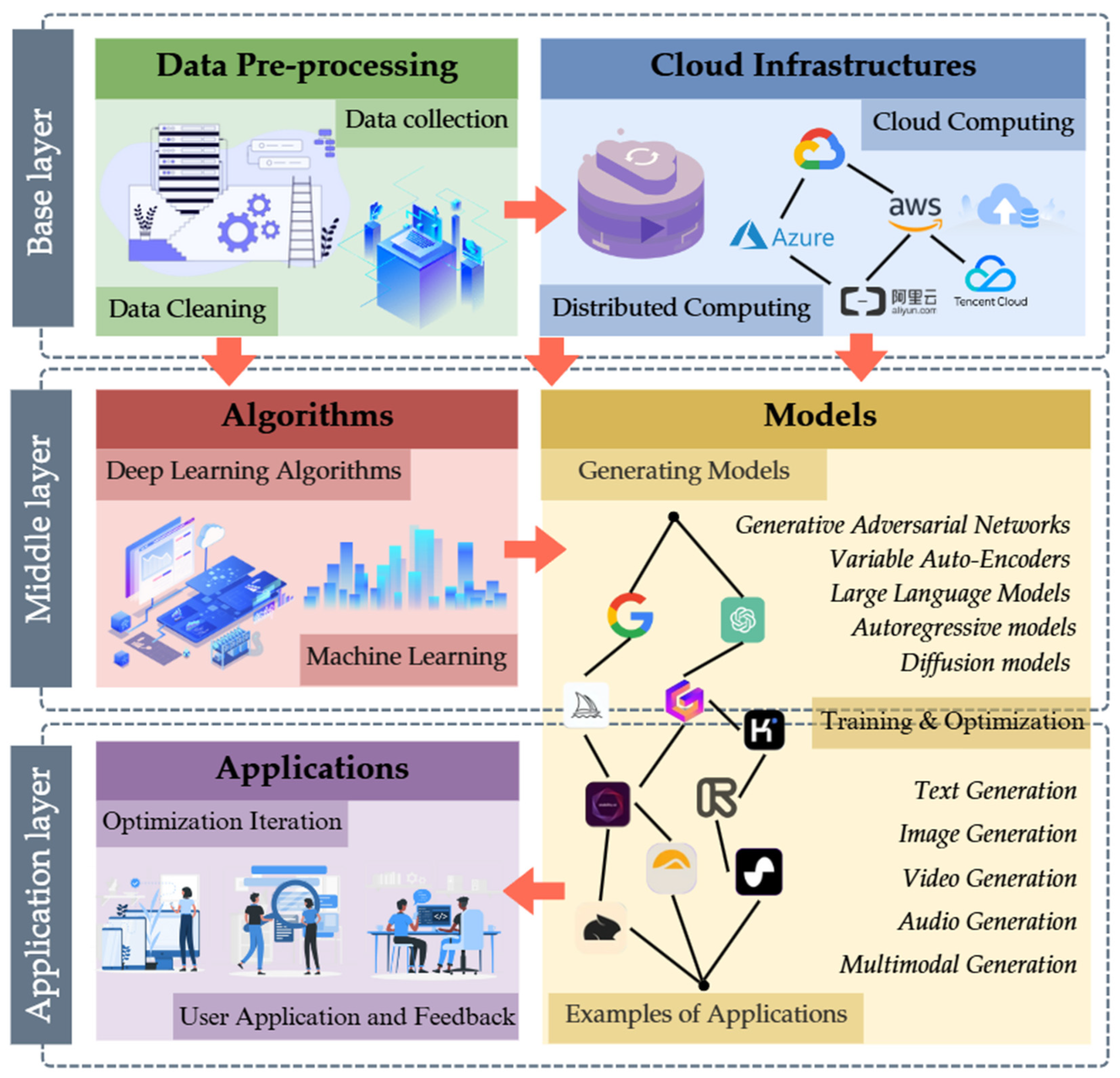
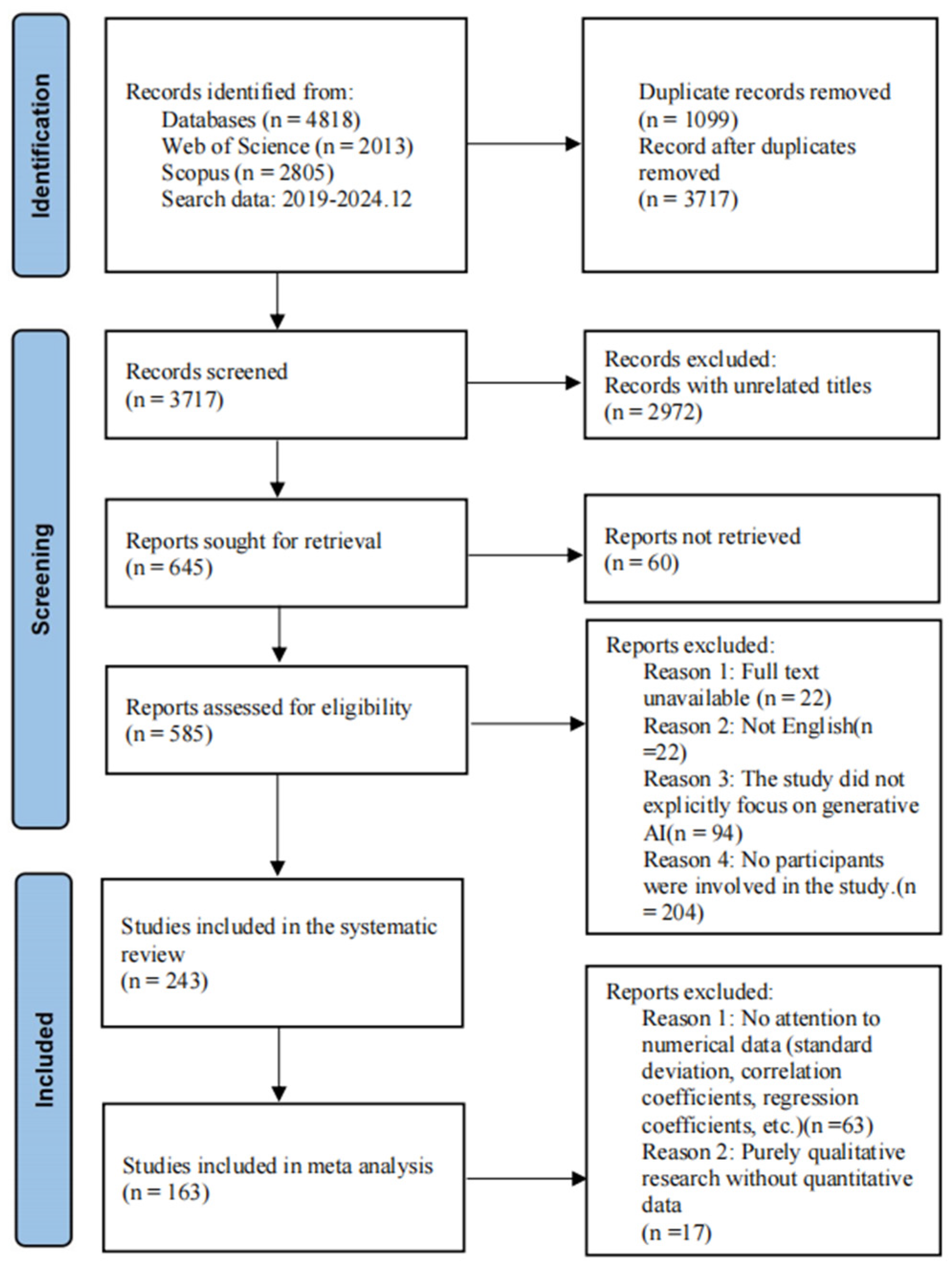
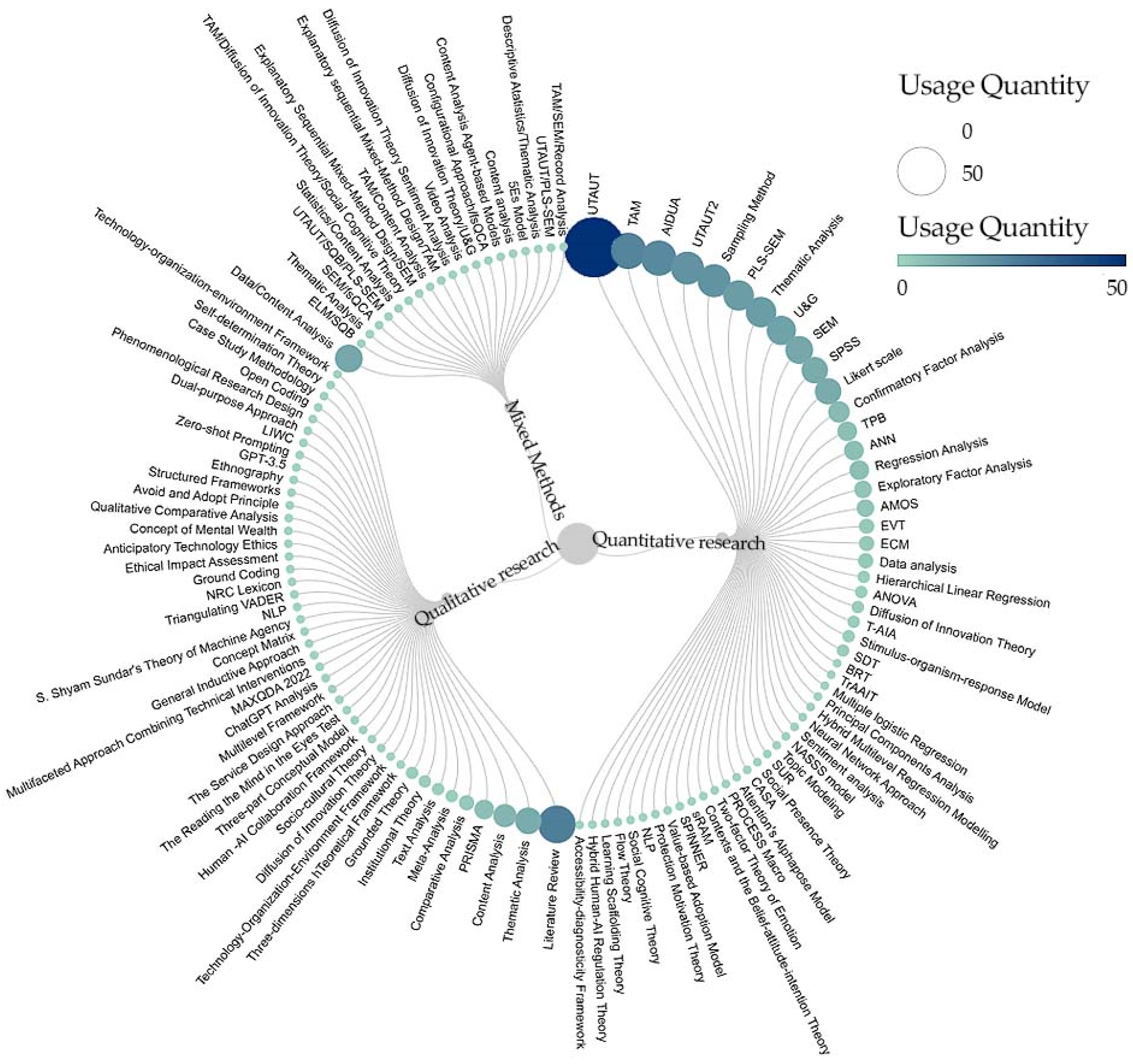
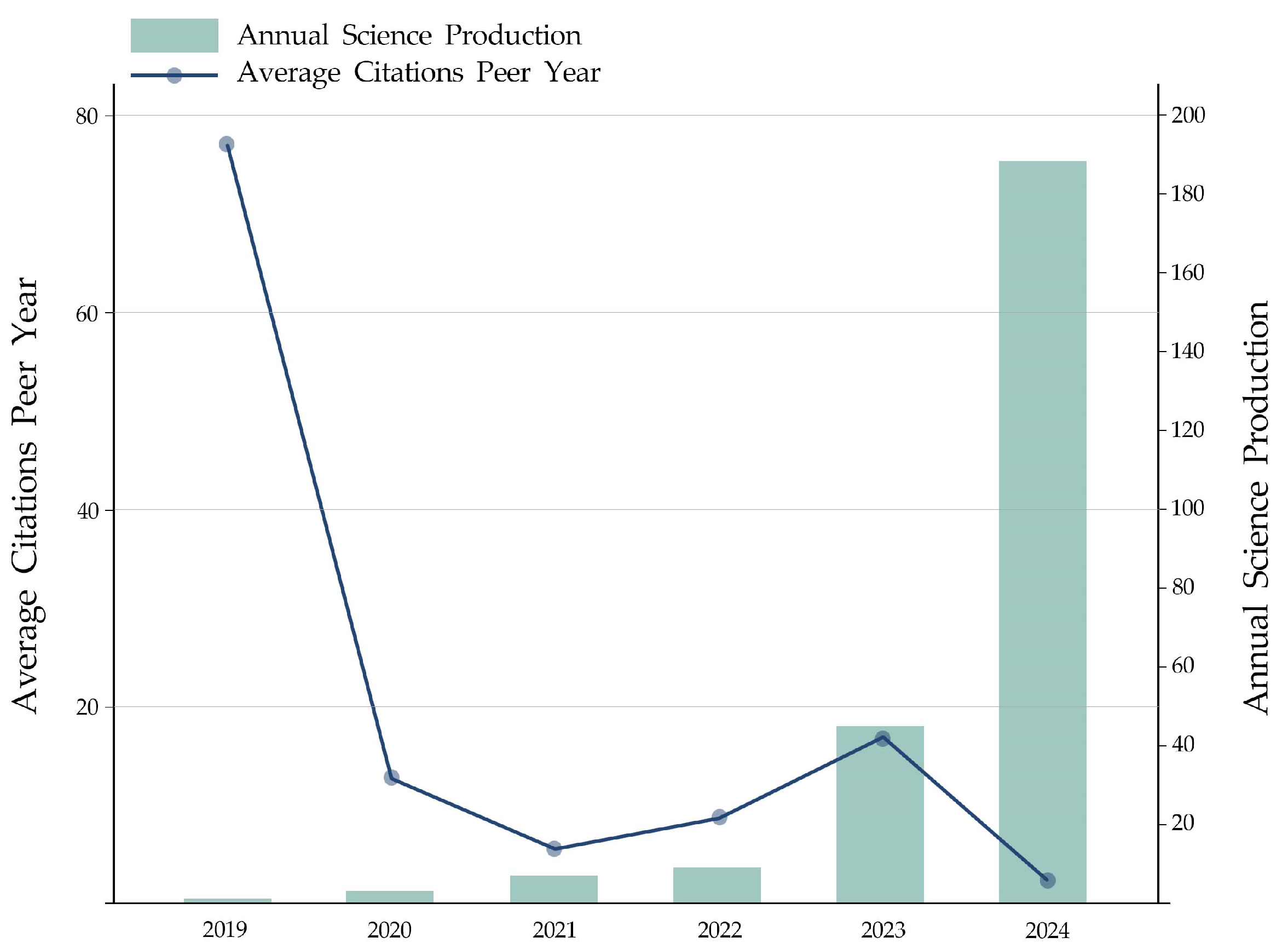

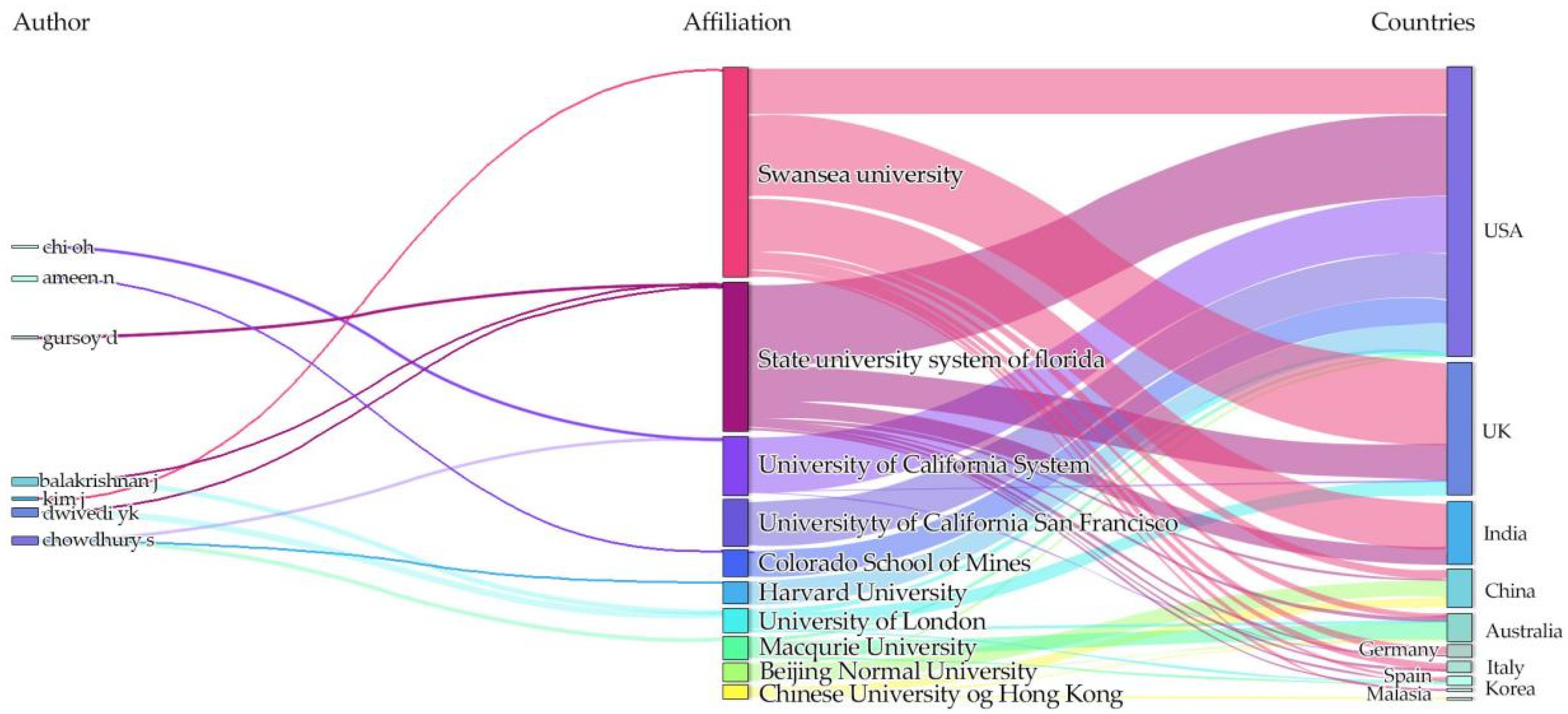
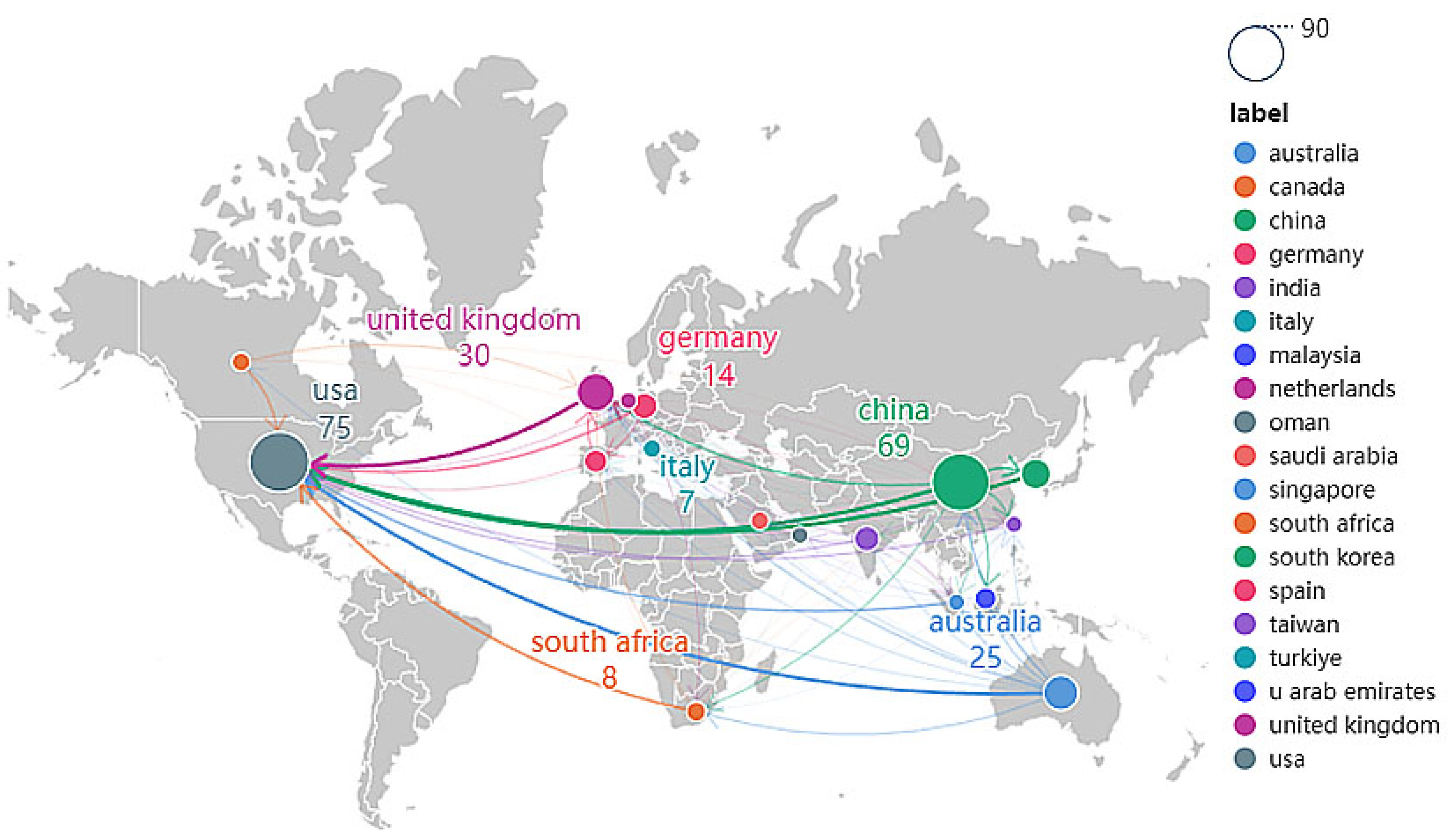
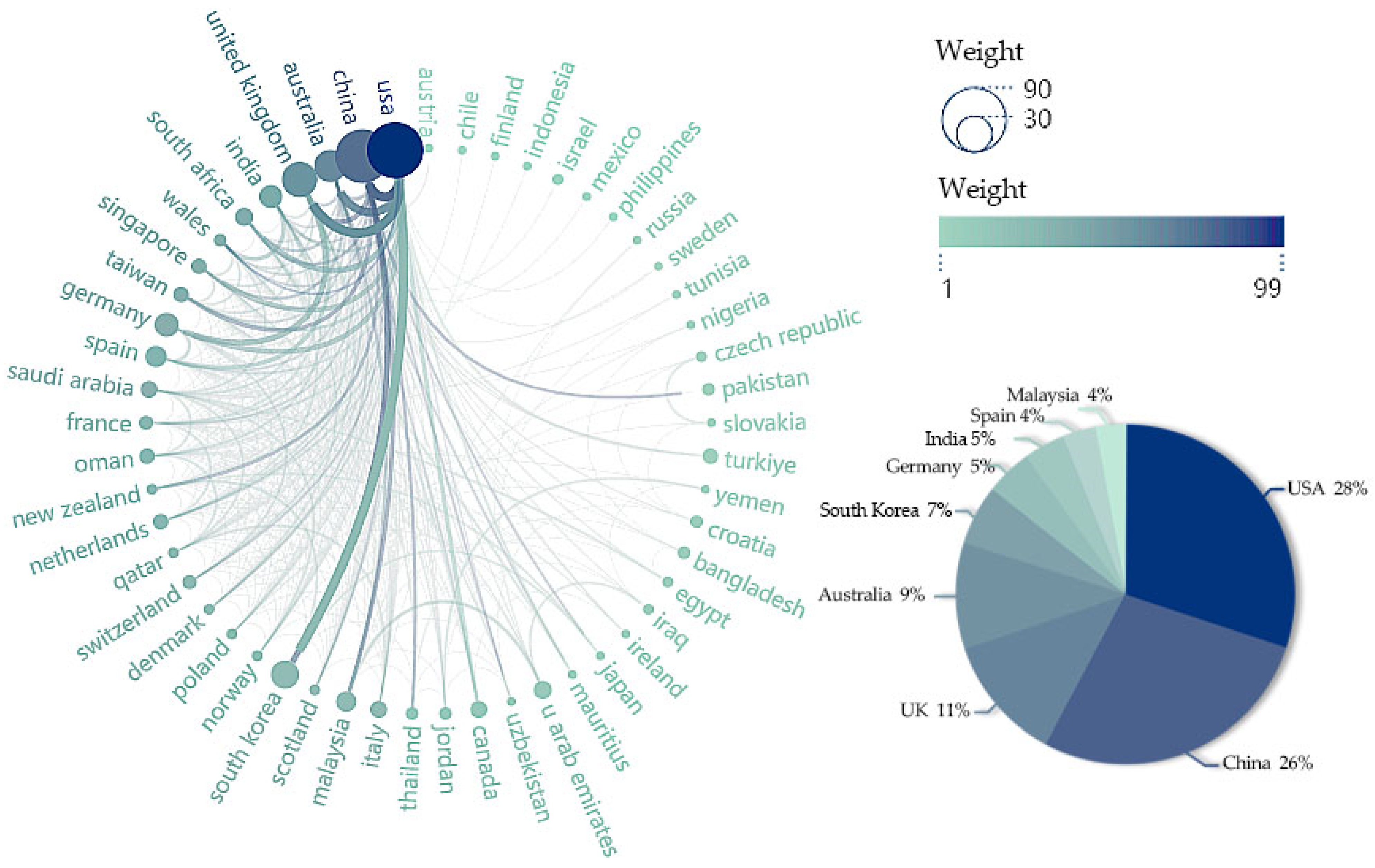
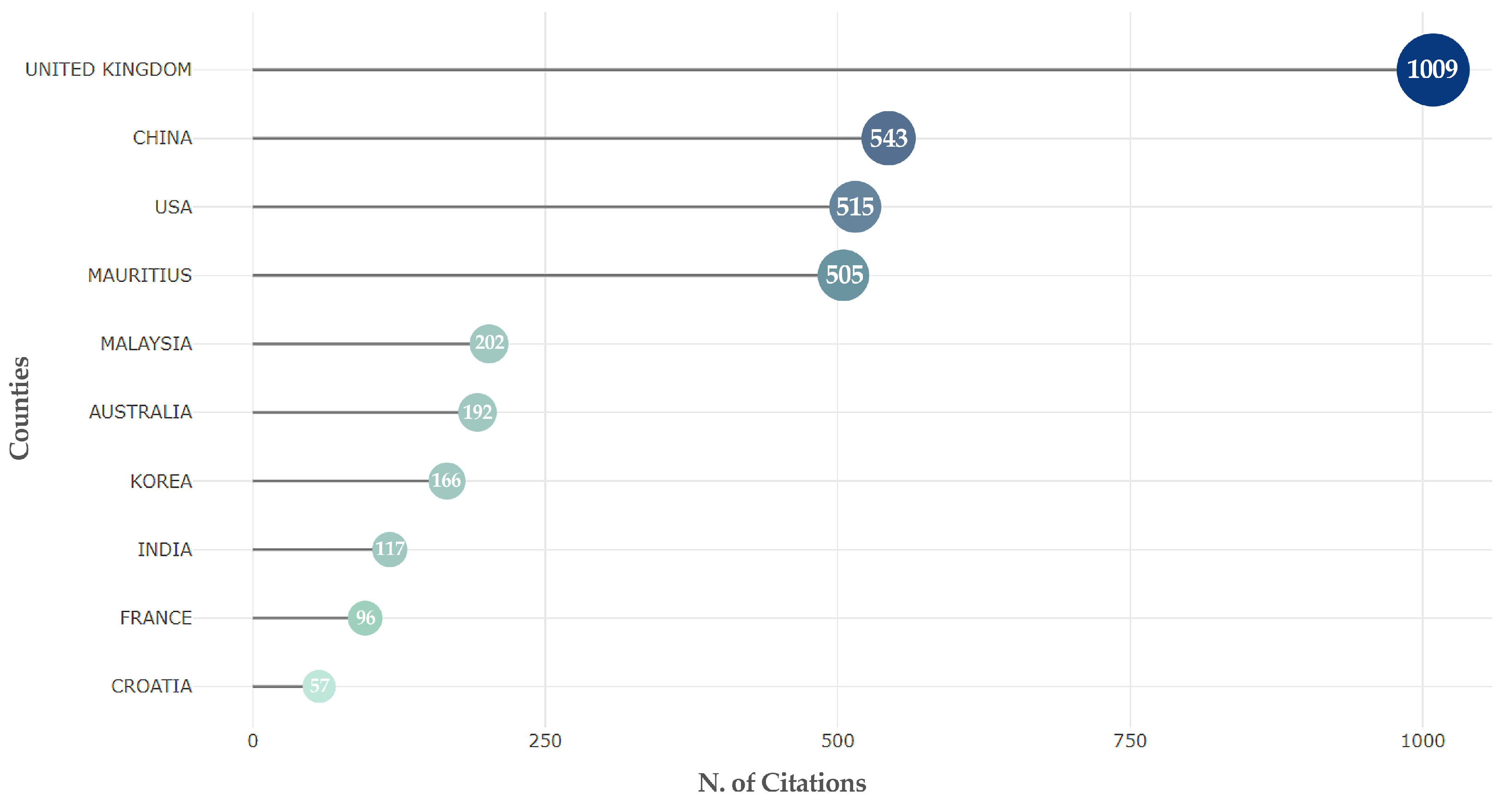
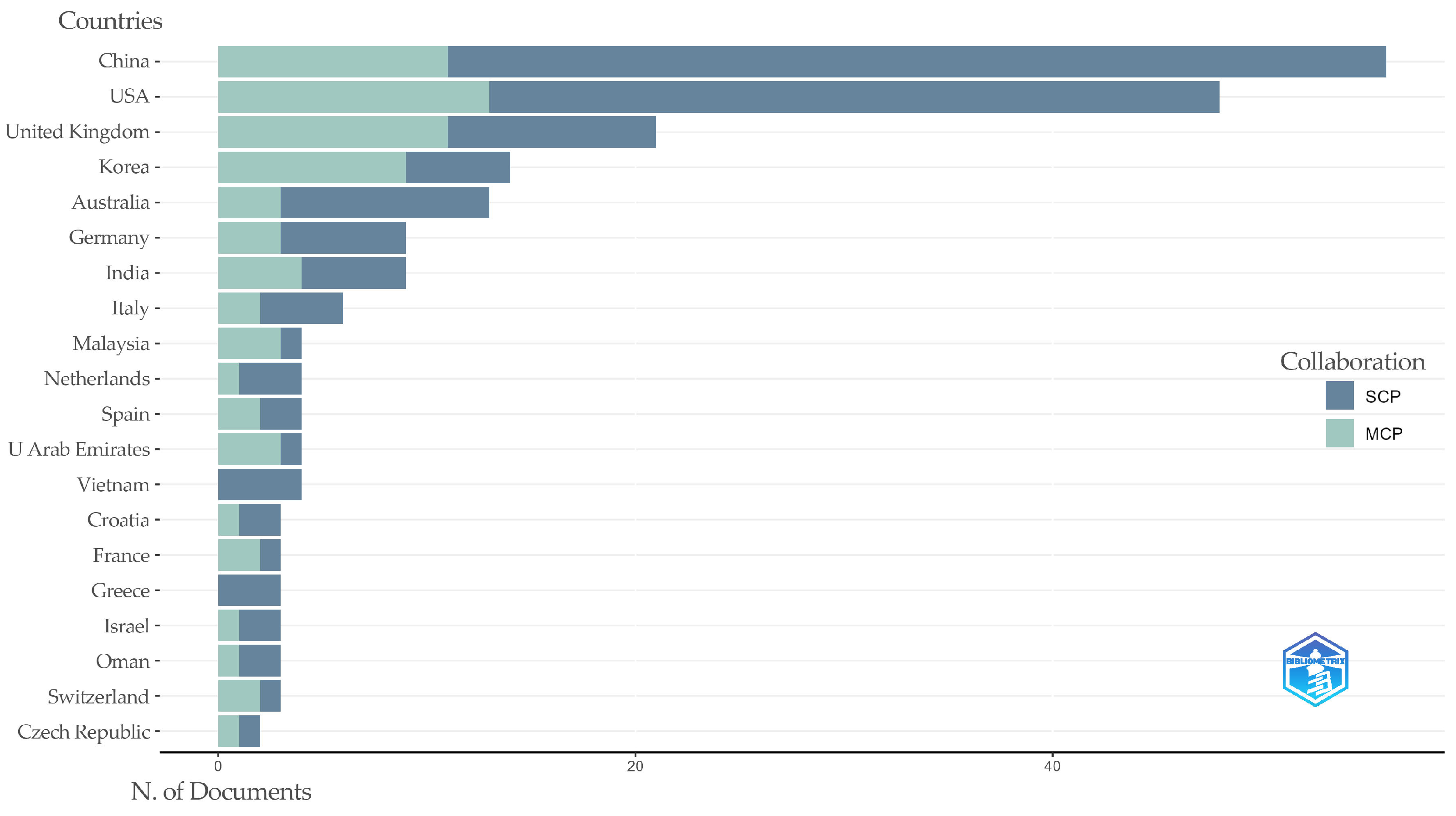
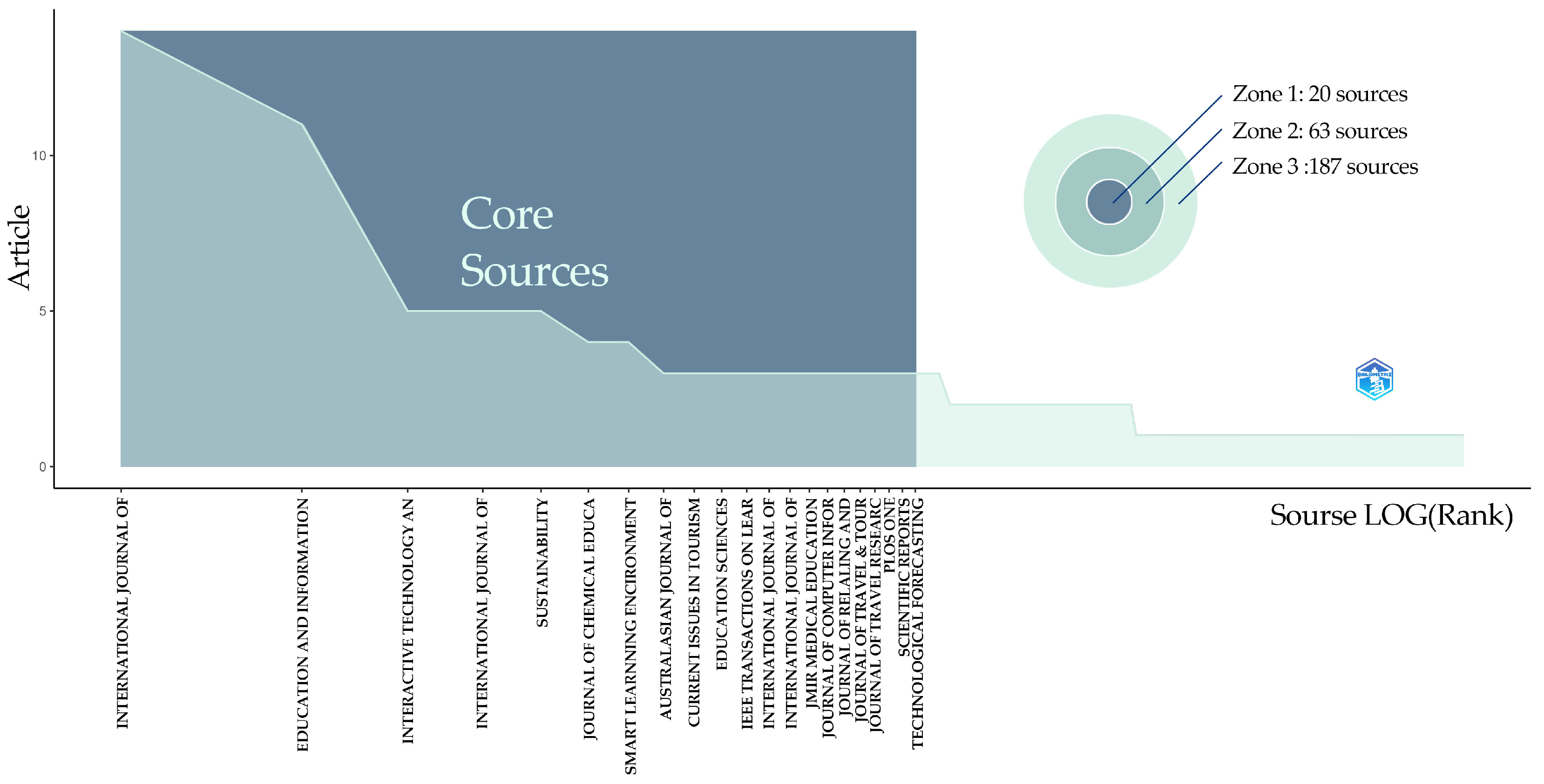
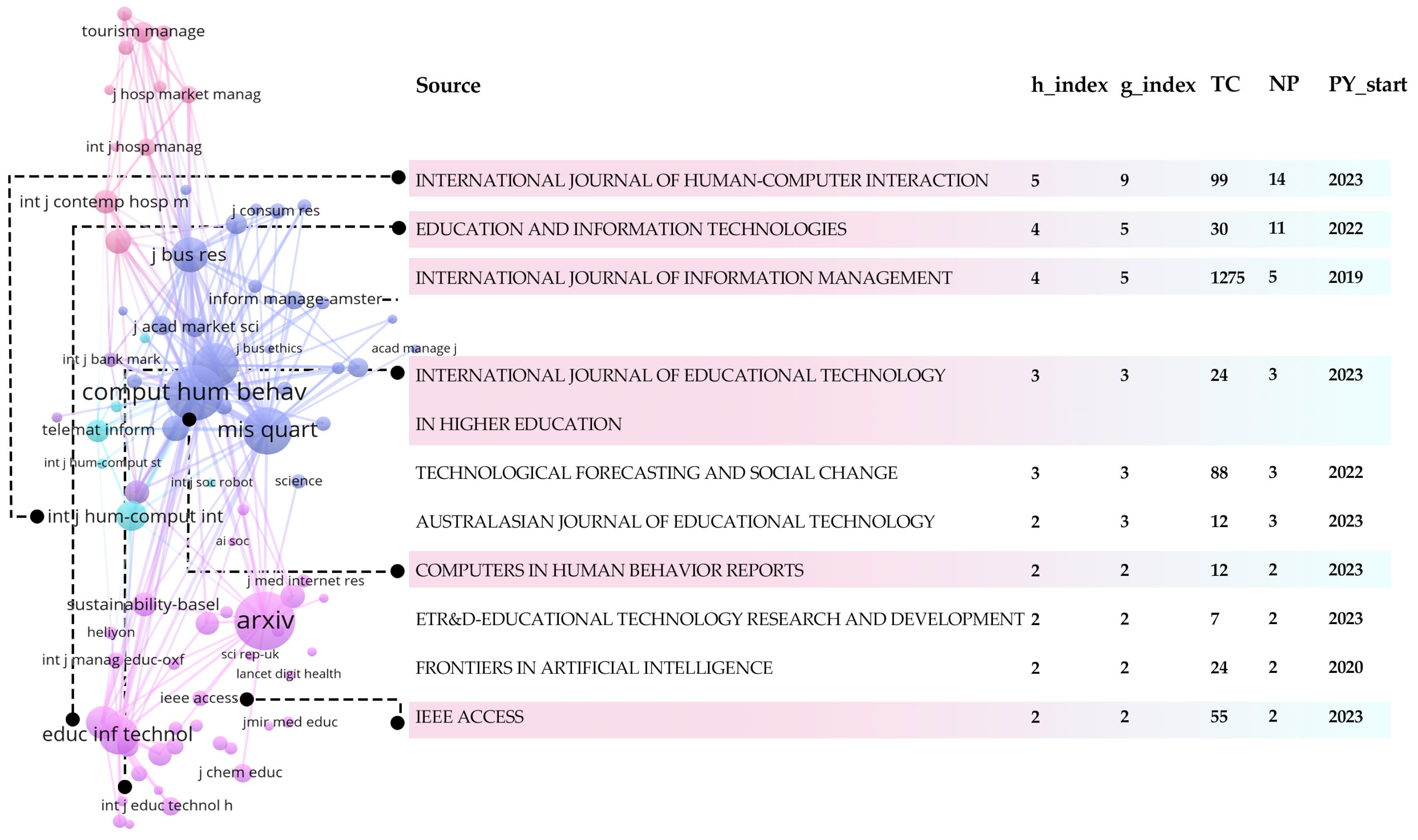
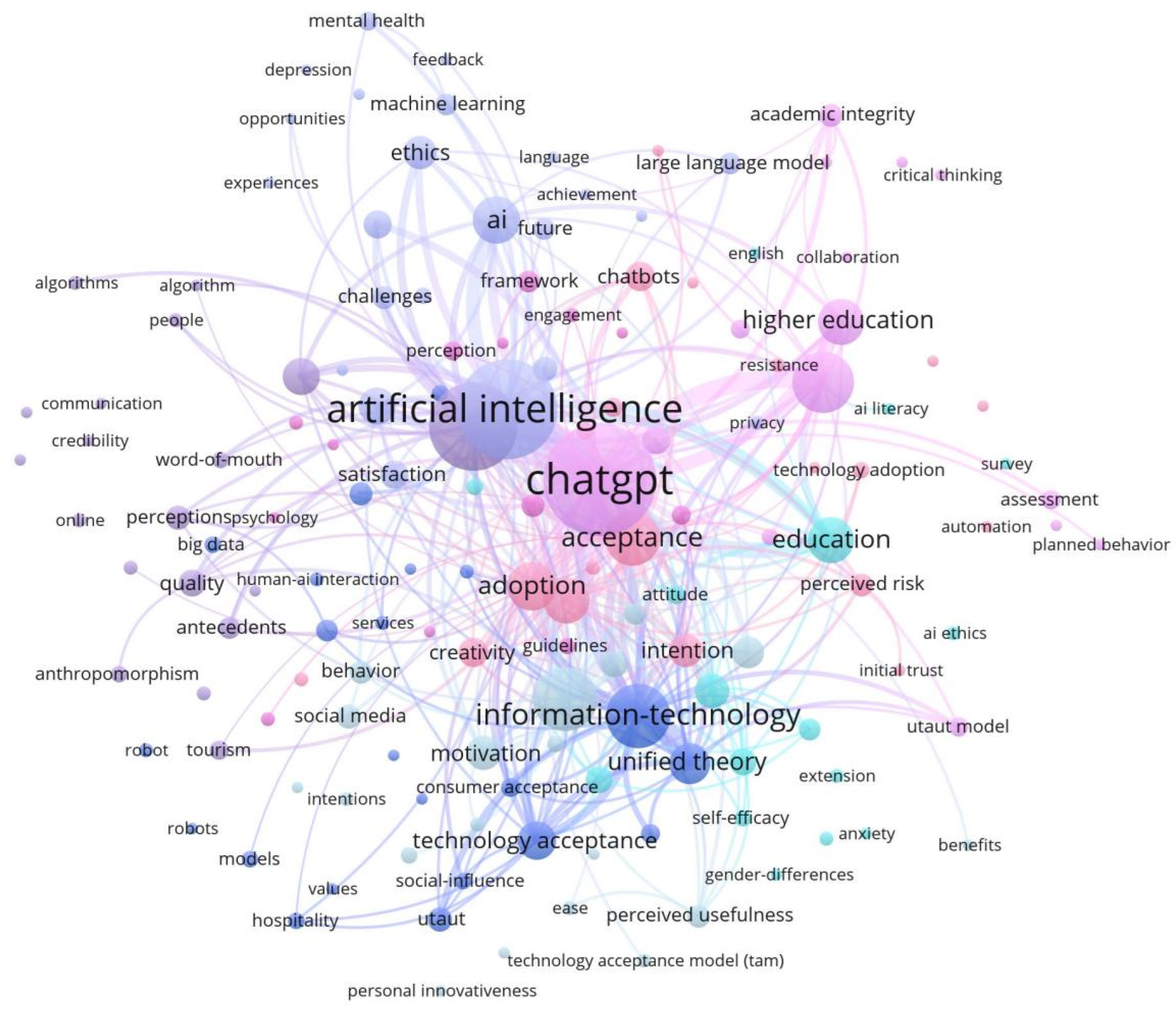
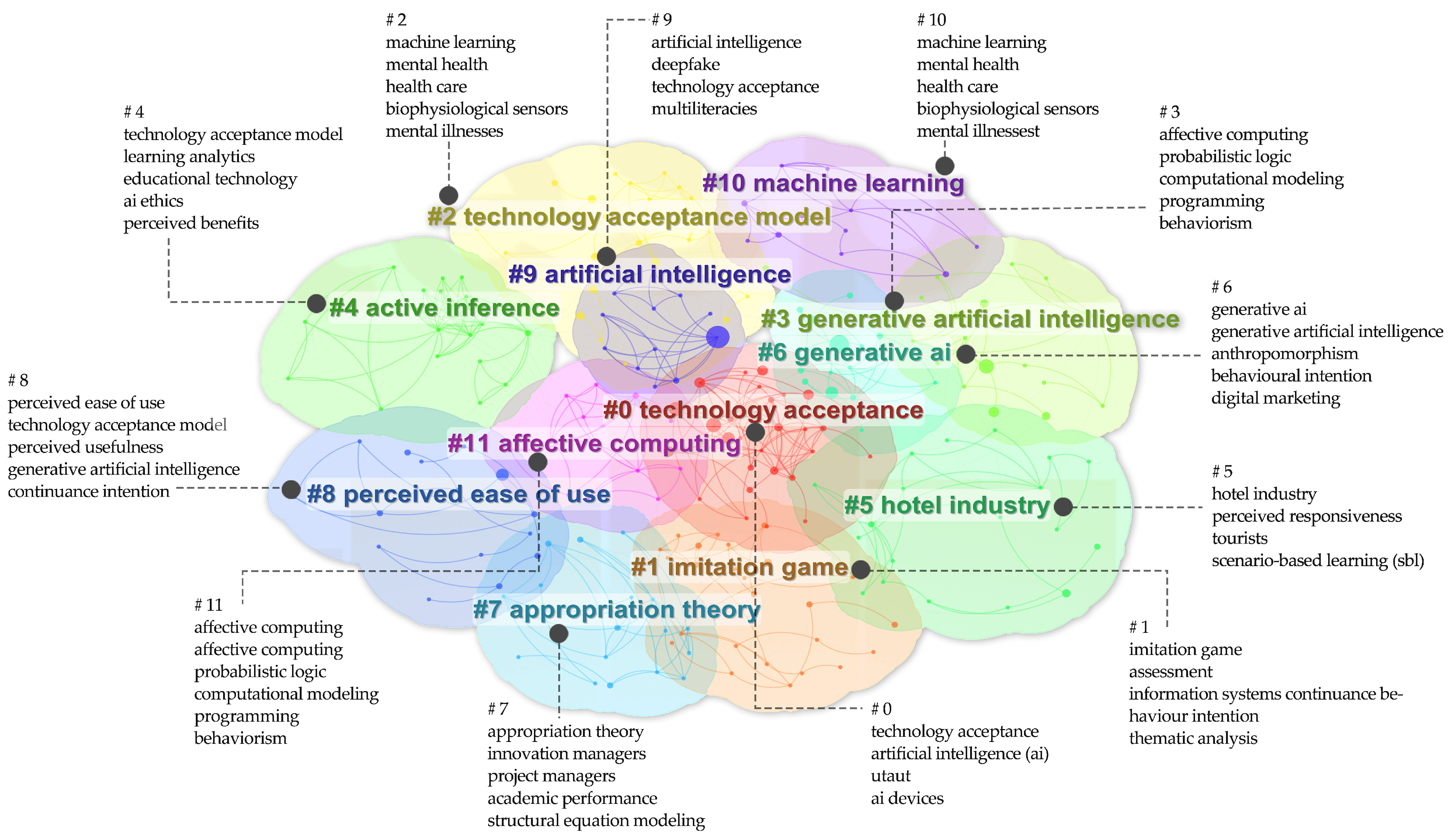
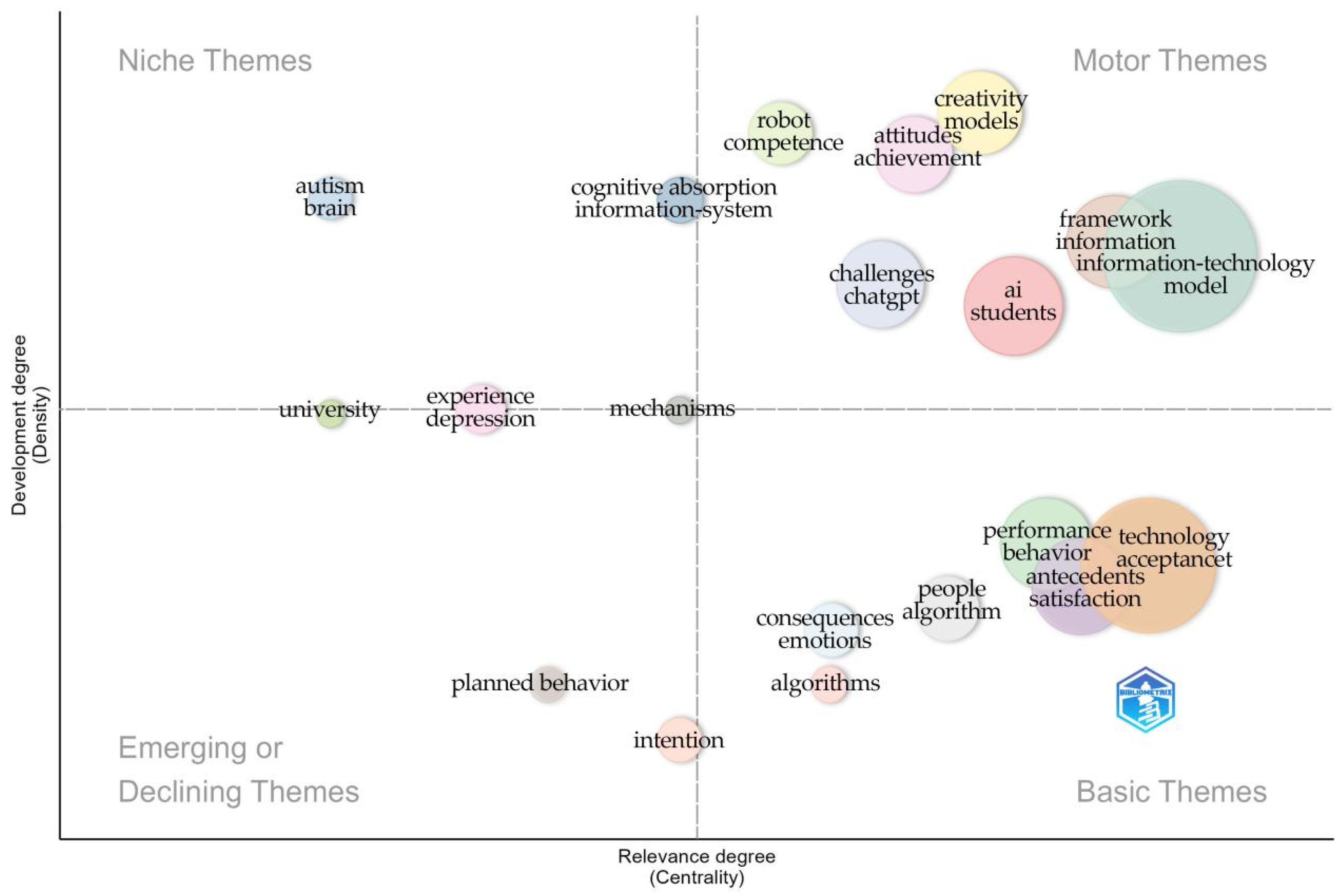
| Topics | Keywords |
|---|---|
| Generative Artificial Intelligence | “AIGC” OR “Generative AI” OR “GenAI” OR “AI-generated content” OR “GANs” |
| AND | |
| User Attitude | user attitude” OR “acceptance” OR “perception” OR “behavior” OR “trust” OR “emotion” OR “reaction” OR “anxiety” OR “creativity” OR “concern” OR “intention” OR “Satisfaction” |
| Inclusion Criteria | Exclusion Criteria | |
|---|---|---|
| Publication Type | Original research published in peer-reviewed publications | Narrative reviews, letters, editorials, commentaries, unpublished manuscripts, meeting abstracts, and consensus statements |
| Case definition | The research must address users’ attitudes toward GenAI and their intention to use it. | The participants had no apparent attitudes or behavioral tendencies |
| Dependent variable | Usage intention, acceptance, adoption, willingness, trust | Other dependent variables |
| Publication period | From January 2019 to December 2024 | Before 2019 |
| Publication language | English | English translation is not available |
| Research Paradigm | Data Collection Method | Number of Studies (%) | Total (%) |
|---|---|---|---|
| quantitative methods | Survey or questionnaire | 150 (89%) | 169 (69.6%) |
| Experimental design | 19 (11%) | ||
| qualitative methods | Interview | 16 (37%) | 43 (17.6%) |
| focus group | 4 (9%) | ||
| observation | 4 (9%) | ||
| Case study | 11 (27%) | ||
| Media | 8 (18%) | ||
| Mixed Methods | Combined method | 31 (12.8%) | 31 (12.8%) |
| # | Theory/Model | Number of Studies |
|---|---|---|
| 1 | Unified Theory of Acceptance and Use of Technology (UTAUT) | 50 |
| 2 | Technology acceptance model (TAM) | 27 |
| 3 | Artificially Intelligent Device Use Acceptance (AIDUA) | 18 |
| 4 | Unified Theory of Acceptance and Use of Technology2 (UTAUT2) | 15 |
| 5 | Use and Gratification (U&G) | 14 |
| 6 | Theory of Planned Behavior (TPB) | 13 |
| 7 | Self-Determination Theory (SDT) | 10 |
| 8 | Social Cognitive Theory (SCT) | 8 |
| 9 | Diffusion of Innovations Theory (DIT) | 8 |
| 10 | Stimulus–Organism Response (SOR) Theory | 5 |
| # | Theory/Model | Number of Studies |
|---|---|---|
| 1 | Diffusion of Innovations Theory (DIT) | 8 |
| 2 | Unified Theory of Acceptance and Use of Technology2 (UTAUT2) | 7 |
| 3 | Unified Theory of Acceptance and Use of Technology (UTAUT) | 6 |
| 4 | Technology acceptance model (TAM) | 6 |
| 5 | Higher-Order Thinking Skills (HOTS) | 4 |
| 6 | Cognitive Appraisal Theory (CAT) | 4 |
| 7 | Social Cognitive Theory (SCT) | 2 |
| 8 | Use and Gratification (U&G) | 2 |
| 9 | Four-C Model | 1 |
| 10 | Computational Creativity Theory (CCT) | 1 |
| # | Dependent Variable | Definition | k | Count |
|---|---|---|---|---|
| 1 | Behavioral Intention | Desire to use technology in the future (Davis 1989) | 369 | 77 |
| 2 | Use Behavior | Use Behavior refers to the actions and patterns exhibited by individuals or groups when they utilize a product, service, technology, or system (Davis 1989) | 94 | 37 |
| 3 | Attitude | The individual’s positive or negative evaluation of performing the behavior (Ajzen 1985) | 106 | 33 |
| 4 | Acceptance | Individual or group perceptions and positive adoption intentions for technology, product, or innovation (Davis 1989) | 67 | 25 |
| 5 | Trust | Perception of confidence against the technology’s integrity and reliability (Morgan and Hunt 1994) | 63 | 22 |
| 6 | Concern | Individuals are concerned about the potential negative impacts or risks of a technology, product, or system (S. S. Kim et al. 2004) | 42 | 14 |
| 7 | Satisfaction | Customers’ emotions based on their expectations and consumption experience (Oliver 1977) | 39 | 12 |
| 8 | Continuance Intention | The extent to which consumers who have used a product or service in the past are willing to continue using the product or service in the future (M. Kim and Chang 2020) | 41 | 11 |
| 9 | Anxiety | Individuals experience anxiety, tension, or restlessness due to uncertainty or potential negative consequences when using new technologies or systems (Higgins and Compeau 1995) | 7 | 5 |
| 10 | Purchase intention | The willingness to purchase the product in the future and the customer’s willingness to buy the product further (Nuanchaona et al. 2021) | 6 | 2 |
| Variable | Definition | Similar Constructs (Alias) | k |
|---|---|---|---|
| Perceived Usefulness | The degree to which a user expects a particular technology to enhance their performance by its use (Davis 1989) | Performance Expectancy, Relative Advantage | 133 |
| Perceived Ease of Use | The degree to which a user expects to use a technology free of effort (Davis 1989) | Effort Expectancy | 116 |
| Social Influence | The extent to which consumers perceive that others (e.g., family and friends) believe they should use a particular technology (Venkatesh et al. 2003) | Social norms, Social Need, Subjective Norms, Social Presence | 96 |
| Perceived Risk | The potential negative consequences or uncertainties that users associate with engaging with GenAI (Dinev and Hart 2006) | Perceived Ethical Risk, Perceived Anxiety | 76 |
| Facilitating Conditions | Consumers’ perceptions of the resources and support available to perform a behavior (Venkatesh et al. 2003) | 64 | |
| Perceived Enjoyment | The extent to which the individual perceives that their attention is focused on the interaction with the technology, is curious during the interaction, and finds the interaction intrinsically enjoyable or interesting (Moon and Kim 2001) | Perceived enjoyment, Hedonic Motivation, Entertainment | 61 |
| Self-efficiency | The individual’s belief in their ability to effectively interact with and utilize generative AI tools to achieve specific creative, analytical, or operational goals (Davis 1989) | Competency Levels, Perceived Competence | 54 |
| Trust | Perception of confidence against the technology’s integrity and reliability (Morgan and Hunt 1994) | Perceived Trust, Perceived Credibility | 50 |
| Attitude | A person’s degree of evaluative effect (like or dislike) towards a target behavior (Ajzen 1985) | 41 | |
| Perceived Value | The subjective evaluation by users of the usefulness, relevance, quality, and benefits derived from content generated by artificial intelligence (Chan and Zhou 2023) | Expected Benefits, Price Value, Perceived Benefits | 41 |
| Creativity | Persons or processes are creative to the extent that they produce creative products, and a product is creative if it meets two conditions: novelty and value (Vigeant 2024) | Personal Innovativeness, Perceived Creativity, and Individual Creativity | 41 |
| Variable | F | df1 | df2 | p-Value |
|---|---|---|---|---|
| Year | 0.402 | 1 | 107 | 0.685 |
| IV (Independent Variable) | 16.947 | 1 | 107 | <0.001 |
| Independent Variable | Estimate | Standard Error | t | df | p | 95% CI | |
|---|---|---|---|---|---|---|---|
| Upper | Lower | ||||||
| Perceived usefulness | 0.323 *** | 0.076 | 4.233 | 107 | <0.001 | 0.172 | 0474 |
| Perceived Ease of Use | 0.184 | 0.077 | 2.379 | 107 | 0.019 | 0.031 | 0.338 |
| (Year 2019–2024) | −0.049 | 0.077 | −0.634 | 107 | 0.528 | −0.201 | 0.104 |
| Variable | k | n | β-Mean | Estimate | Standard Error | z | p | 95% CI | |
|---|---|---|---|---|---|---|---|---|---|
| Lower | Upper | ||||||||
| Behavioral Intention | |||||||||
| Perceived Usefulness | 63 | 26,429 | 0.32 *** | 0.284 | 0.022 | 12.771 | <0.001 | 0.241 | 0.328 |
| Perceived Ease of Use | 44 | 20,702 | 0.135 *** | 0.136 | 0.025 | 5.369 | <0.001 | 0.088 | 0.185 |
| Social Influence | 42 | 17,088 | 0.192 *** | 0.177 | 0.026 | 8.758 | <0.001 | 0.125 | 0.228 |
| Perceived Risk | 30 | 15,674 | −0.0686 | −0.059 | 0.029 | −2.035 | 0.042 | −0.116 | −0.002 |
| Facilitating Conditions | 28 | 11,913 | 0.13 *** | 0.153 | 0.031 | 4.954 | <0.001 | 0.082 | 0.213 |
| Perceived Enjoyment | 21 | 9993 | 0.259 *** | 0.222 | 0.036 | 6.234 | <0.001 | 0.152 | 0.291 |
| Self-efficacy | 19 | 4932 | 0.272 *** | 0.232 | 0.042 | 5.485 | <0.001 | 0.149 | 0.315 |
| Trust | 15 | 6175 | 0.299 *** | 0.267 | 0.048 | 5.965 | <0.001 | 0.133 | 0.382 |
| Perceived Value | 14 | 5641 | 0.217 *** | 0.164 | 0.043 | 3.837 | <0.001 | 0.080 | 0.247 |
| Attitude | 12 | 6222 | 0.535 *** | 0.400 | 0.055 | 7.337 | <0.001 | 0.293 | 0.507 |
| Creativity | 11 | 5729 | 0.179 *** | 0.199 | 0.048 | 4.170 | <0.001 | 0.105 | 0.292 |
| Use Behavior | |||||||||
| Behavioral Intention | 22 | 11,077 | 0.532 *** | 0.454 | 0.044 | 10.411 | <0.001 | 0.369 | 0.540 |
| Facilitating Conditions | 10 | 3713 | 0.281 *** | 0.217 | 0.059 | 3.702 | <0.001 | 0.102 | 0.332 |
| Social Influence | 6 | 2179 | 0.329 | 0.237 | 0.099 | 2.395 | 0.017 | 0.043 | 0.430 |
| Perceived Usefulness | 5 | 2863 | 0.4798 *** | 0.365 | 0.077 | 4.744 | <0.001 | 0.214 | 0.516 |
| Perceived Ease of Use | 4 | 2813 | 0.313 ** | 0.234 | 0.083 | 2.806 | 0.005 | 0.071 | 0.397 |
| Trust | 4 | 1785 | 0.458 *** | 0.477 | 0.097 | 4.938 | <0.001 | 0.287 | 0.666 |
| Attitude | 4 | 1164 | 0.224 | 0.198 | 0.095 | 2.087 | 0.037 | 0.012 | 0.383 |
| Creativity | 4 | 1059 | 0.109 | 0.194 | 0.104 | 1.874 | 0.061 | −0.009 | 0.397 |
| Attitude | |||||||||
| Perceived Usefulness | 17 | 8012 | 0.401 *** | 0.307 | 0.041 | 7.574 | <0.001 | 0.228 | 0.387 |
| Perceived Ease of Use | 13 | 6345 | 0.0963 | 0.067 | 0.039 | 1.736 | 0.083 | −0.009 | 0.143 |
| Perceived Risk | 6 | 2308 | −0.1605 ** | −0.142 | 0.054 | −2.608 | 0.009 | −0.248 | −0.035 |
| Trust | 5 | 2666 | 0.29 *** | 0.275 | 0.070 | 3.908 | <0.001 | 0.137 | 0.413 |
| Perceived Enjoyment | 5 | 2352 | 0.364 *** | 0.276 | 0.076 | 3.650 | <0.001 | 0.128 | 0.424 |
| Social Influence | 4 | 1687 | 0.251 ** | 0.206 | 0.068 | 3.045 | 0.002 | 0.073 | 0.338 |
| Perceived Value | 3 | 1126 | 0.207 *** | 0.243 | 0.061 | 3.990 | <0.001 | 0.123 | 0.362 |
| Creativity | 4 | 1271 | 0.2635 | 0.167 | 0.083 | 2.013 | 0.044 | 0.004 | 0.329 |
| Facilitating Conditions | 3 | 1058 | 0.219 | 0.218 | 0.085 | 2.561 | 0.01 | 0.051 | 0.385 |
| Acceptance | |||||||||
| Attitude | 7 | 3800 | 0.536 *** | 0.512 | 0.103 | 4.989 | <0.001 | 0.311 | 0.713 |
| Perceived Ease of Use | 7 | 2638 | 0.163 | 0.245 | 0.121 | 2.015 | 0.044 | 0.007 | 0.483 |
| Perceived usefulness | 6 | 2518 | 0.444 *** | 0.449 | 0.123 | 3.645 | <0.001 | 0.207 | 0.690 |
| Social Influence | 5 | 2149 | 0.293 | 0.236 | 0.119 | 1.983 | 0.047 | 0.003 | 0.470 |
| Trust | 4 | 1689 | 0.513 *** | 0.484 | 0.120 | 4.027 | <0.001 | 0.248 | 0.720 |
| Facilitating Conditions | 3 | 1194 | 0.125 | 0.041 | 0.153 | 0.265 | 0.791 | −0.260 | 0.341 |
| Perceived Risk | 3 | 1905 | −0.105 | −0.154 | 0.259 | −0.595 | 0.552 | −0.661 | 0.353 |
| Creativity | 3 | 1335 | 0.118 | 0.118 | 0.237 | 0.498 | 0.618 | −0.346 | 0.582 |
| Trust | |||||||||
| Perceived Usefulness | 6 | 2908 | 0.441 *** | 0.574 | 0.087 | 6.568 | <0.001 | 0.402 | 0.745 |
| Perceived Enjoyment | 3 | 1660 | 0.204 | 0.192 | 0.146 | 1.309 | 0.190 | −0.095 | 0.479 |
| Perceived Value | 4 | 866 | 0.234 *** | 0.321 | 0.097 | 3.318 | <0.001 | 0.131 | 0.511 |
| Social Influence | 7 | 2255 | 0.218 | 0.234 | 0.098 | 2.380 | 0.017 | 0.041 | 0.427 |
| Perceived Risk | 11 | 3227 | −0.131 ** | −0.204 | 0.077 | −2.655 | 0.008 | −0.355 | −0.053 |
| Perceived Ease of Use | 5 | 2412 | 0.187 | 0.176 | 0.113 | 1.557 | 0.119 | −0.046 | 0.398 |
| Concern | |||||||||
| Perceived Risk | 3 | 981 | 0.504 *** | 0.486 | 0.113 | 4.306 | <0.001 | 0.265 | 0.708 |
| Perceived Usefulness | 5 | 1377 | 0.462 ** | 0.246 | 0.094 | 2.604 | 0.009 | 0.061 | 0.431 |
| Social Influence | 4 | 1383 | 0.039 | 0.062 | 0.087 | 0.716 | 0.474 | −0.108 | 0.232 |
| Perceived Ease of Use | 3 | 814 | 0.062 | 0.069 | 0.096 | 0.716 | 0.474 | −0.120 | 0.258 |
| Creativity | |||||||||
| Self-efficacy | 5 | 1388 | 0.4836 *** | 0.480 | 0.114 | 4.226 | <0.001 | 0.257 | 0.702 |
| Behavioral Intention | 3 | 1051 | 0.511 ** | 0.414 | 0.153 | 2.712 | 0.007 | 0.115 | 0.712 |
| Variable | Q | df | p | I2 (%) | 95% CI | |
|---|---|---|---|---|---|---|
| Lower | Upper | |||||
| Behavioral Intention | 2432 | 274 | <0.001 | 92.936% | 92.936 | 95.159 |
| Use | 299.109 | 52 | <0.001 | 86.708% | 82.708 | 94.05 |
| Attitude | 257.557 | 58 | <0.001 | 81.65% | 75.573 | 90.858 |
| Acceptance | 371.206 | 23 | <0.001 | 92.236 | 85.910 | 96.502 |
| Trust | 284.223 | 36 | <0.001 | 90.679 | 86.131 | 95.108 |
| Concern | 41.728 | 12 | <0.001 | 81.298 | 61.3 | 97.138 |
| Domain | Variable | Estimate | Standard Error | z | p | 95% CI | |
|---|---|---|---|---|---|---|---|
| Lower | Upper | ||||||
| Education (k = 178, n = 26,294) | Perceived Usefulness | 0.300 *** | 0.028 | 10.860 | <0.001 | 0.246 | 0.354 |
| Perceived playfulness | 0.188 *** | 0.041 | 4.554 | <0.001 | 0.107 | 0.269 | |
| Perceived Value | 0.147 | 0.061 | 2.414 | 0.016 | 0.028 | 0.266 | |
| Social Influence | 0.169 *** | 0.032 | 5.262 | <0.001 | 0.106 | 0.232 | |
| Perceived Risk | −0.054 | 0.032 | −1.666 | 0.096 | −0.118 | 0.010 | |
| Facilitating Conditions | 0.078 | 0.038 | 2.050 | 0.040 | 0.003 | 0.153 | |
| Self-Efficacy | 0.241 *** | 0.046 | 5.257 | <0.001 | 0.151 | 0.330 | |
| Attitude | 0.405 *** | 0.068 | 6.100 | <0.001 | 0.275 | 0.538 | |
| Perceived Ease of Use | 0.136 *** | 0.027 | 4.952 | <0.001 | 0.082 | 0.190 | |
| Creativity | 0.213 *** | 0.056 | 3.806 | <0.001 | 0.103 | 0.322 | |
| Trust | 0.237 *** | 0.065 | 3.651 | <0.001 | 0.110 | 0.365 | |
| Creative Industry (k = 39, n = 2937) | Perceived Usefulness | 0.201 ** | 0.075 | 2.686 | 0.007 | 0.054 | 0.348 |
| Perceived Ease of Use | 0.057 | 0.095 | 0.595 | 0.552 | −0.130 | 0.243 | |
| Perceived Value | 0.178 | 0.126 | 1.416 | 0.157 | −0.068 | 0.424 | |
| Social Influence | 0.142 | 0.078 | 1.832 | 0.067 | −0.010 | 0.295 | |
| Perceived Risk | −0.041 | 0.085 | −0.474 | 0.635 | −0.208 | 0.127 | |
| Facilitating Conditions | 0.387 *** | 0.096 | 4.017 | <0.001 | 0.198 | 0.576 | |
| Self-Efficacy | 0.184 | 0.123 | 1.488 | 0.137 | −0.058 | 0.426 | |
| Healthcare (k = 12, n = 995) | Perceived Usefulness | 0.335 ** | 0.112 | 2.996 | 0.003 | 0.116 | 0.555 |
| Perceived Risk | −0.031 | 0.087 | −0.354 | 0.723 | −0.202 | 0.140 | |
| Social Influence | 0.082 | 0.108 | 0.758 | 0.448 | −0.129 | 0.292 | |
| Organization (k = 12, n = 1191) | Perceived Ease of Use | −0.022 | 0.134 | −0.163 | 0.871 | −0.285 | 0.241 |
| Perceived Usefulness | 0.076 ** | 0.025 | 3.101 | 0.002 | 0.028 | 0.125 | |
| Facilitating Conditions | 0.101 ** | 0.038 | 2.684 | 0.007 | 0.027 | 0.175 | |
| Consumer Service Scenarios (k = 27, n = 3261) | Perceived Usefulness | 0.289 *** | 0.056 | 5.153 | <0.001 | 0.179 | 0.398 |
| Trust | 0.280 *** | 0.083 | 3.394 | <0.001 | 0.118 | 0.442 | |
| Perceived Ease of Use | 0.351 *** | 0.089 | 3.954 | <0.001 | 0.177 | 0.526 | |
| Social Influence | 0.334 *** | 0.074 | 4.531 | <0.001 | 0.189 | 0.478 | |
| Perceived playfulness | 0.359 *** | 0.074 | 4.829 | <0.001 | 0.213 | 0.504 | |
| Attitude | 0.309 *** | 0.070 | 4.436 | <0.001 | 0.173 | 0.446 | |
| Self-Efficacy | 0.323 | 0.179 | 1.809 | 0.070 | −0.027 | 0.673 | |
| General-Purpose Scenarios (k = 21, n = 3718) | Perceived Usefulness | 0.344 *** | 0.072 | 4.815 | <0.001 | 0.204 | 0.484 |
| Perceived Ease of Use | 0.206 ** | 0.076 | 2.722 | 0.006 | 0.058 | 0.354 | |
| Social Influence | 0.240 ** | 0.091 | 2.646 | 0.008 | 0.062 | 0.418 | |
| Facilitating Conditions | 0.150 | 0.090 | 1.663 | 0.096 | −0.027 | 0.327 | |
| Perceived Value | 0.169 | 0.098 | 1.718 | 0.086 | −0.024 | 0.361 | |
| Perceived Risk | −0.600 ** | 0.208 | −2.879 | 0.004 | −1.008 | −0.192 | |
| Education (n = 93) | ||
|---|---|---|
| Positive Factor | Negative Factor | Regulatory Factor |
| Perceived confirmation (Tian et al. 2024), cost ethical awareness (Zhu et al. 2024), usefulness, social presence, legitimacy of the tool, enjoyment, motivation (Tiwari et al. 2023), knowledge sharing (Duong et al. 2023), design, interactivity, perceived trust (Salifu et al. 2024), functional elements (Ibrahim et al. 2023), emotional intelligence (Zhou and Zhang 2024), anthropomorphism, design novelty, trust (Polyportis and Pahos 2024), feedback and quality, subject norms (Almogren et al. 2024), perceived value (Chan and Zhou 2023), information system (Thongsri et al. 2024), subjective norms, perceived behavioral control (Al-Qaysi et al. 2024), perceived use contexts (Y. Chang et al. 2022), autonomy (Niu et al. 2024), course level, motivation, confidence (Amoozadeh et al. 2024), potential of GenAI enjoyment (Liu et al. 2024), content quality, emotional wellbeing, perceived utility (Almufarreh 2024), personal ability, perceived intelligence, perceived enjoyment (Dahri et al. 2024), personal innovativeness (Hernandez et al. 2023; Nawaz et al. 2024) | Perceived cost ethical awareness, perceived ethical risk, artificial intelligence ethical anxiety (W. Li 2024; Zhu et al. 2024), psychological risk (Wu et al. 2022), perceived cost (Chan and Zhou 2023), potential risks (L. Law 2024), fake information (Amaro et al. 2024), over-reliance, accuracy, ethical considerations (Abu Hammour et al. 2023), impeding learning, producing inaccurate information (Anderson et al. 2024) | Institutional policy (Polyportis and Pahos 2024), gender, age, experience, voluntariness of use, teachers’ teaching level and experience, students’ major (X. Lin et al. 2024), academic disciplines, geographical locations, cultural orientations (Yusuf et al. 2024), SDT motivation (Y. Wang et al. 2024), educational backgrounds (Yao and Abd Halim 2024), AI training courses (Pellas 2023), task–technology fit (Du and Lv 2024) |
| Creative Arts and Design (n = 28) | ||
|---|---|---|
| Positive Factor | Negative Factor | Regulatory Factor |
| Optimism, creativity, trait curiosity (indirect) (Y. Wang and Zhang 2023), confirmation, satisfaction ,personal innovativeness (Yu et al. 2024), design priorities, AI literacy (T. Li et al. 2023), perceived relevance, autonomy, competence (Latikka et al. 2023), auxiliary action (Saadi and Yang 2023), perceptual intelligence, personify, individuation (Zhou and Zhang 2024), AI image filter (Papadopoulou et al. 2024), perceived Intelligence (C. Gu et al. 2024), satisfaction, perceived usefulness, self-efficacy, technology trust (H. Ma and Li 2024), social system, individual innovativeness, communication channels, AI anxiety, relative advantage, performance expectancy, effort expectancy, facilitating conditions (Qiu et al. 2024) | AI anxiety (anxiety about GenAI learning (AL), anxiety about job substitution (JP), and anxiety about socio-technical blindness (SB) in the use of GenAI (Yin et al. 2023), privacy concerns information illusion (Zhou and Zhang 2024), copyright issue (C. Wang 2024), the label of an AI artwork (made by AI or made by humans), the perception of creativity, the sense of awe (Kokkoris et al. 2023), perceived eeriness (C. Gu et al. 2024), social influence | Habit (Y. Wang and Zhang 2023), educational level (Yin et al. 2023), functional factor, art background, art experience (Lyu et al. 2022), gender, design art level, education level (C. Wang 2024) |
| Healthcare (n = 24) | ||
|---|---|---|
| Positive Factor | Negative Factor | Regulatory Factor |
| Information credibility, perceived application value and reliability, decision-making (Stevens and Stetson 2023), depression levels, perceived usefulness, and parasocial interactions (Park and Kim 2023), performance expectancy, price value, descriptive norm, psychological distress, the potential to increase accuracy, speed, and efficiency in medical decision making (Amann et al. 2023), transparency, autonomy (Haber et al. 2024), trust, information, credibility, system performance, application value (Shahsavar and Choudhury 2023), AI smartness, AI transparency (Hou et al. 2024), initial trust, performance expectation, effort expectations, trust tendency, social influence (X. Wang and Wang 2024) | Images inaccuracies (Ozmen and Schwarz 2024), AI hesitancy and effort expectancy, privacy and security issues, questions of accuracy and authenticity, ethical and legal issues, lack of control (Xu and Wang 2024), generated hype (Gravina et al. 2024) | Personal innovation, task complexity (X. Wang and Wang 2024) |
| Organization (n = 20) | ||
|---|---|---|
| Positive Factor | Negative Factor | Regulatory Factor |
| Performance expectancy, perceived usefulness (Herani and Angela 2024), facilitating conditions, hedonic motivation, performance expectancy (Maican et al. 2023), agile leadership, innovation orientation, agile leadership (Cimino et al. 2024), perceived usefulness, perceived ease of use, perceived enjoyment, anthropomorphism (V. Gupta 2024), compatibility, organizational size, competition intensity, perceived ease of use, trust, facilitating conditions, perceived value, perceived autonomy, perceived usefulness (Tanantong et al. 2024), AI engagement, AI familiarity (De Vreede et al. 2024), coercive pressure, normative pressure, mimetic pressure, fairness, accountability, transparency, accuracy, autonomy (Rana et al. 2024), user experience (Marimon et al. 2024), functional value, social value, emotional value, epistemic value, information control (Huynh 2024) | Effort expectancy, social influence, perceived customer value (PCV) (Maican et al. 2023), information sensitivity (Huynh 2024), regulatory support, complexity (Prasad Agrawal 2024) | Interaction convenience, system quality, training and support, technology experience, domain experience (V. Gupta 2024), public knowledge, private knowledge (Figueiredo et al. 2022) |
| Rating | Author | h_Index | g_Index | TC | NP | PY_Start |
|---|---|---|---|---|---|---|
| 1 | Gursory D | 5 | 5 | 817 | 5 | 2019 |
| 2 | Kim J | 3 | 4 | 16 | 4 | 2023 |
| 3 | Park J | 3 | 3 | 12 | 4 | 2023 |
| 4 | AL-Emran M | 2 | 2 | 8 | 2 | 2023 |
| 5 | Baek TH | 2 | 2 | 39 | 2 | 2023 |
| 6 | Balakrishnan J | 2 | 2 | 795 | 2 | 2022 |
| 7 | Chi OH | 2 | 2 | 131 | 2 | 2022 |
| 8 | Chi OHX | 2 | 2 | 625 | 2 | 2019 |
| 9 | Chiu TKF | 2 | 2 | 55 | 2 | 2023 |
| 10 | Choudhury S | 2 | 2 | 809 | 2 | 2023 |
| Count | Central | Year | Institution | Country |
|---|---|---|---|---|
| 11 | 0.27 | 2021 | State University System of Florida | USA |
| 7 | 0.14 | 2020 | University of London | UK |
| 6 | 0 | 2024 | University of California System | USA |
| 6 | 0.16 | 2019 | University of Johannesburg | South Africa |
| 5 | 0.01 | 2023 | Chinese University of Hong Kong | China |
| 5 | 0 | 2019 | Washington State University | USA |
| 5 | 0 | 2024 | University of Pennsylvania | USA |
| 4 | 0.01 | 2024 | University of Houston | USA |
| Research Focus | Current Gaps | Potential Issues | Future Research Directions |
|---|---|---|---|
| Theoretical Model Development | Traditional models do not fit GenAI | Neglect of emotional motivations and individual differences | Cross-level integration, diverse variable systems |
| Sample Heterogeneity Analysis | High I2 heterogeneity across studies | Weak predictive power; unclear mechanisms | Group-specific path analysis and inclusion of moderators |
| Multimodal Acceptance Mechanisms | Overemphasis on text-based tools | Ignorance of modality-specific perceptual differences | Cross-modal comparisons |
| Cross-Cultural Research | Lack of cultural diversity in samples | Variable effects differ across cultures | International collaboration |
| Human-AI Co-Creation | Blurred roles, reduced cognitive agency | Creativity erosion | Mechanism for co-creation, cognitive boundary research |
Disclaimer/Publisher’s Note: The statements, opinions and data contained in all publications are solely those of the individual author(s) and contributor(s) and not of MDPI and/or the editor(s). MDPI and/or the editor(s) disclaim responsibility for any injury to people or property resulting from any ideas, methods, instructions or products referred to in the content. |
© 2025 by the authors. Licensee MDPI, Basel, Switzerland. This article is an open access article distributed under the terms and conditions of the Creative Commons Attribution (CC BY) license (https://creativecommons.org/licenses/by/4.0/).
Share and Cite
Chen, J.; Xie, W.; Xie, Q.; Hu, A.; Qiao, Y.; Wan, R.; Liu, Y. A Systematic Review of User Attitudes Toward GenAI: Influencing Factors and Industry Perspectives. J. Intell. 2025, 13, 78. https://doi.org/10.3390/jintelligence13070078
Chen J, Xie W, Xie Q, Hu A, Qiao Y, Wan R, Liu Y. A Systematic Review of User Attitudes Toward GenAI: Influencing Factors and Industry Perspectives. Journal of Intelligence. 2025; 13(7):78. https://doi.org/10.3390/jintelligence13070078
Chicago/Turabian StyleChen, Junjie, Wei Xie, Qing Xie, Anshu Hu, Yiran Qiao, Ruoyu Wan, and Yuhan Liu. 2025. "A Systematic Review of User Attitudes Toward GenAI: Influencing Factors and Industry Perspectives" Journal of Intelligence 13, no. 7: 78. https://doi.org/10.3390/jintelligence13070078
APA StyleChen, J., Xie, W., Xie, Q., Hu, A., Qiao, Y., Wan, R., & Liu, Y. (2025). A Systematic Review of User Attitudes Toward GenAI: Influencing Factors and Industry Perspectives. Journal of Intelligence, 13(7), 78. https://doi.org/10.3390/jintelligence13070078





